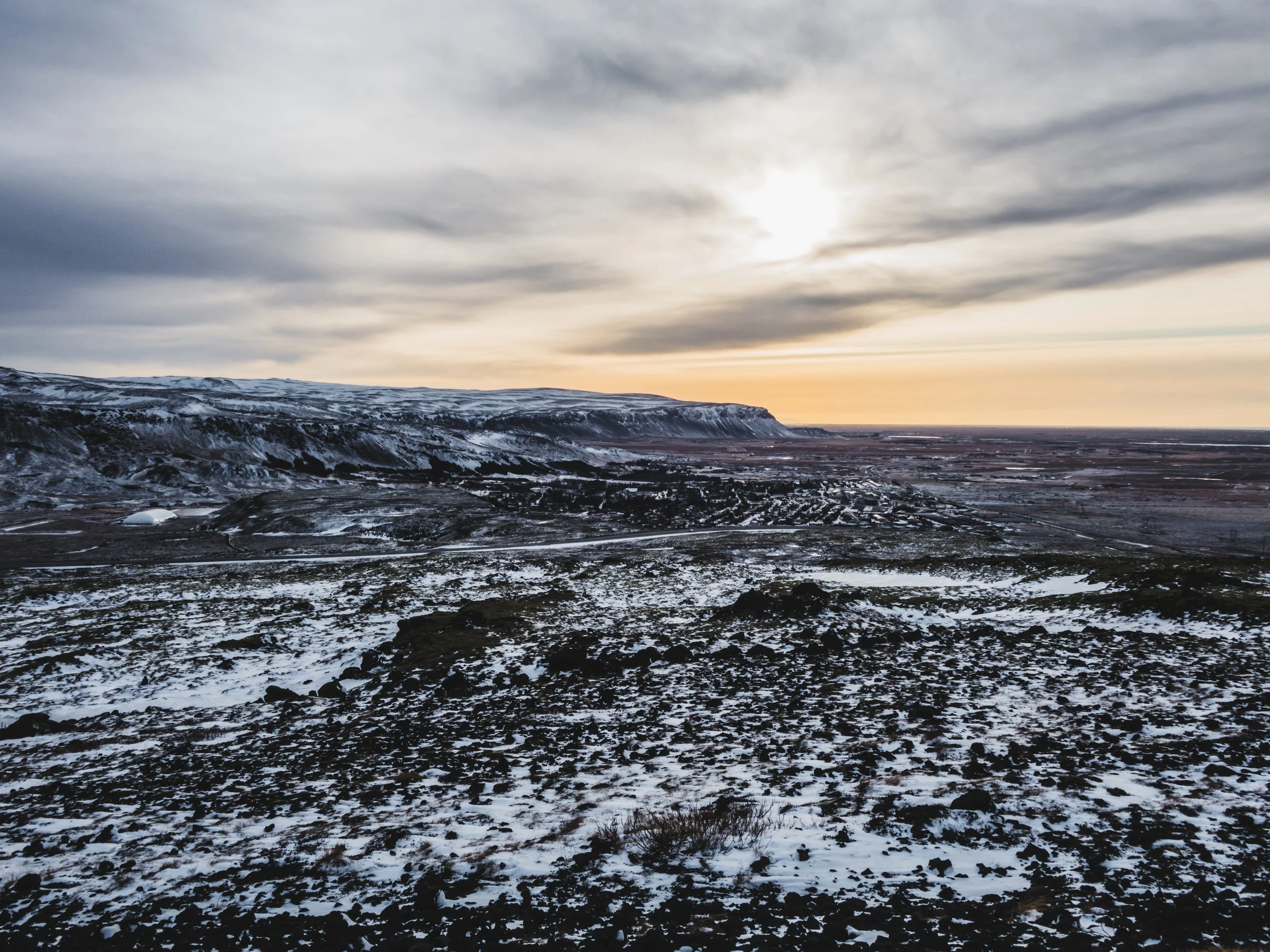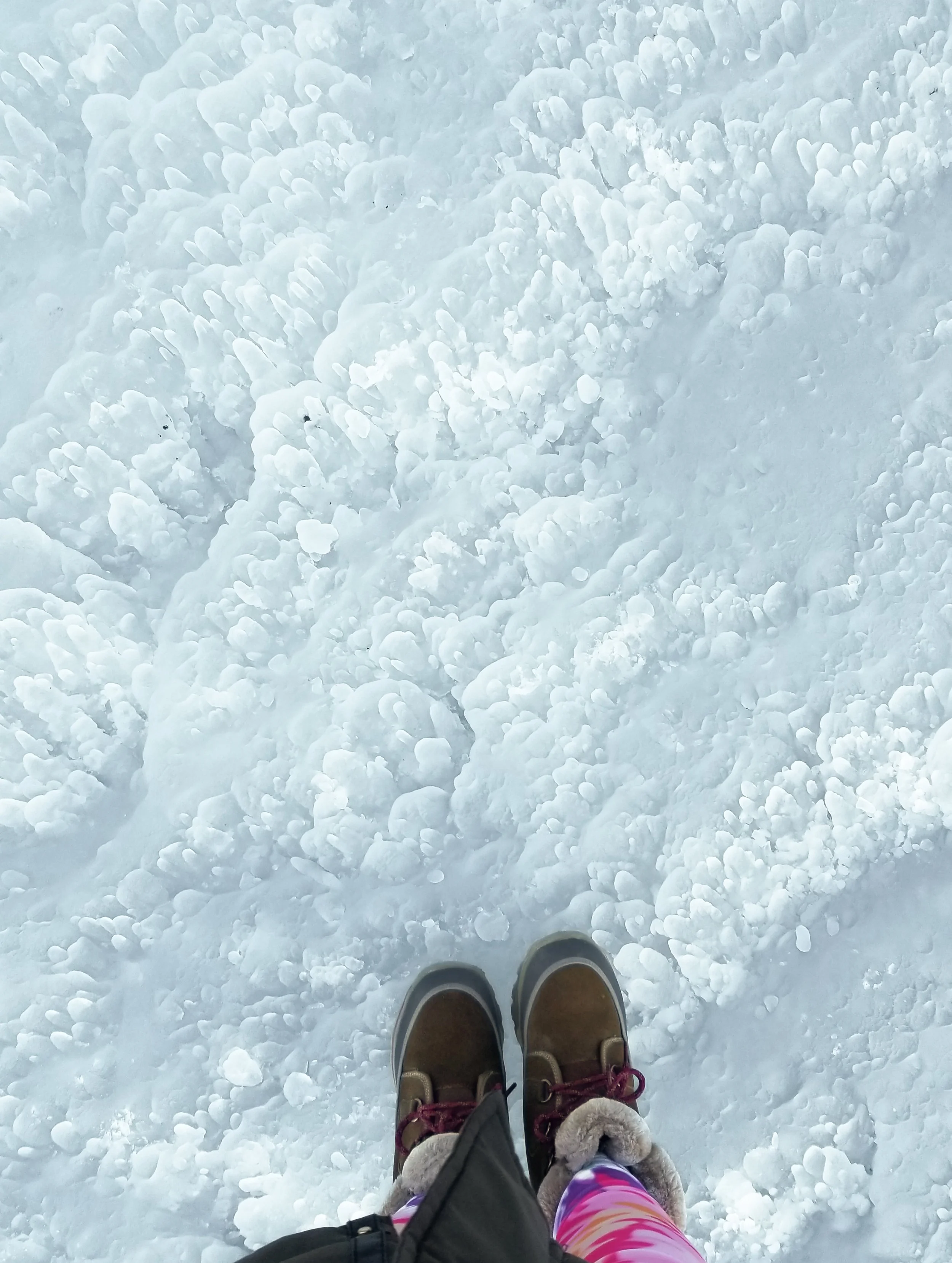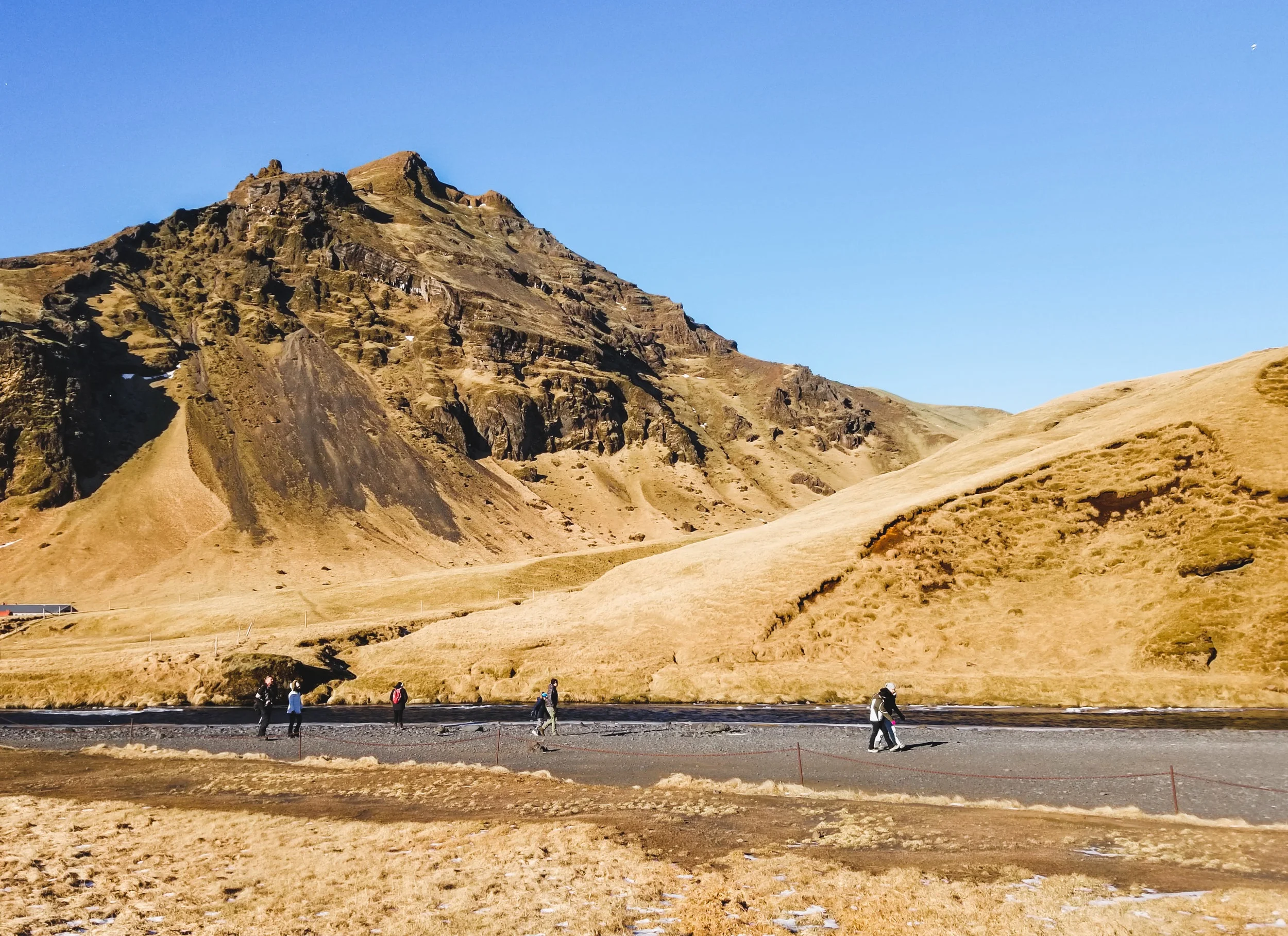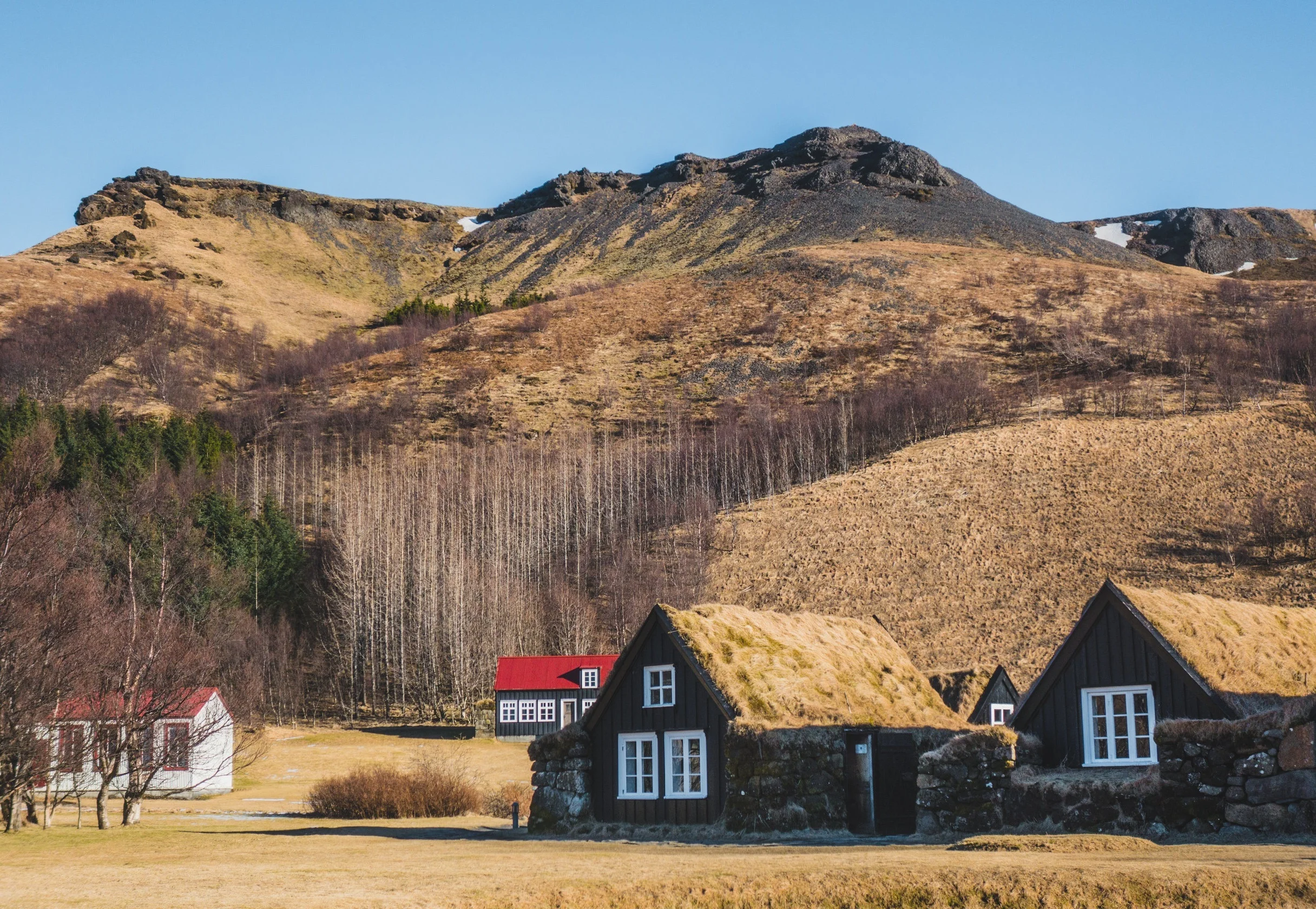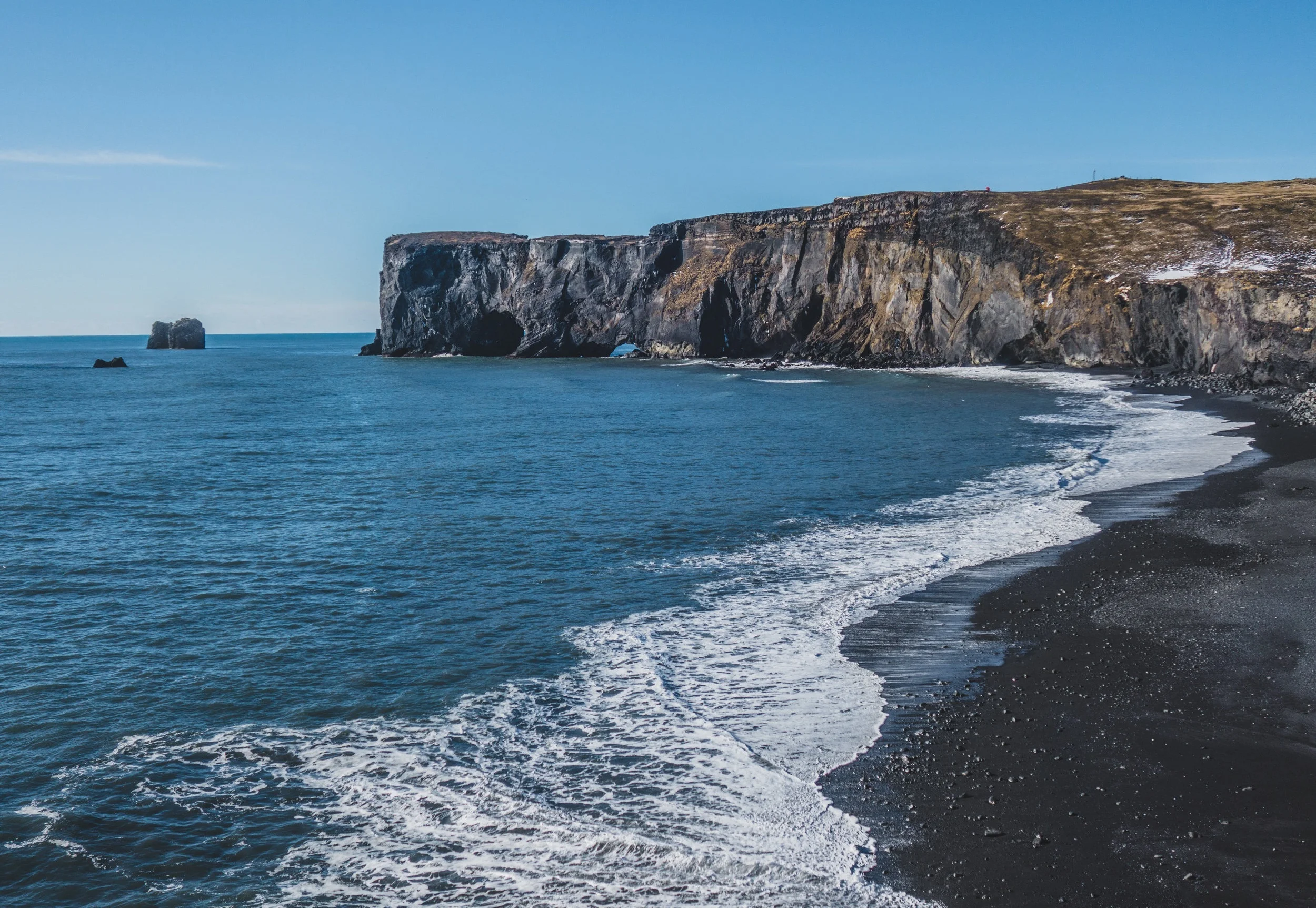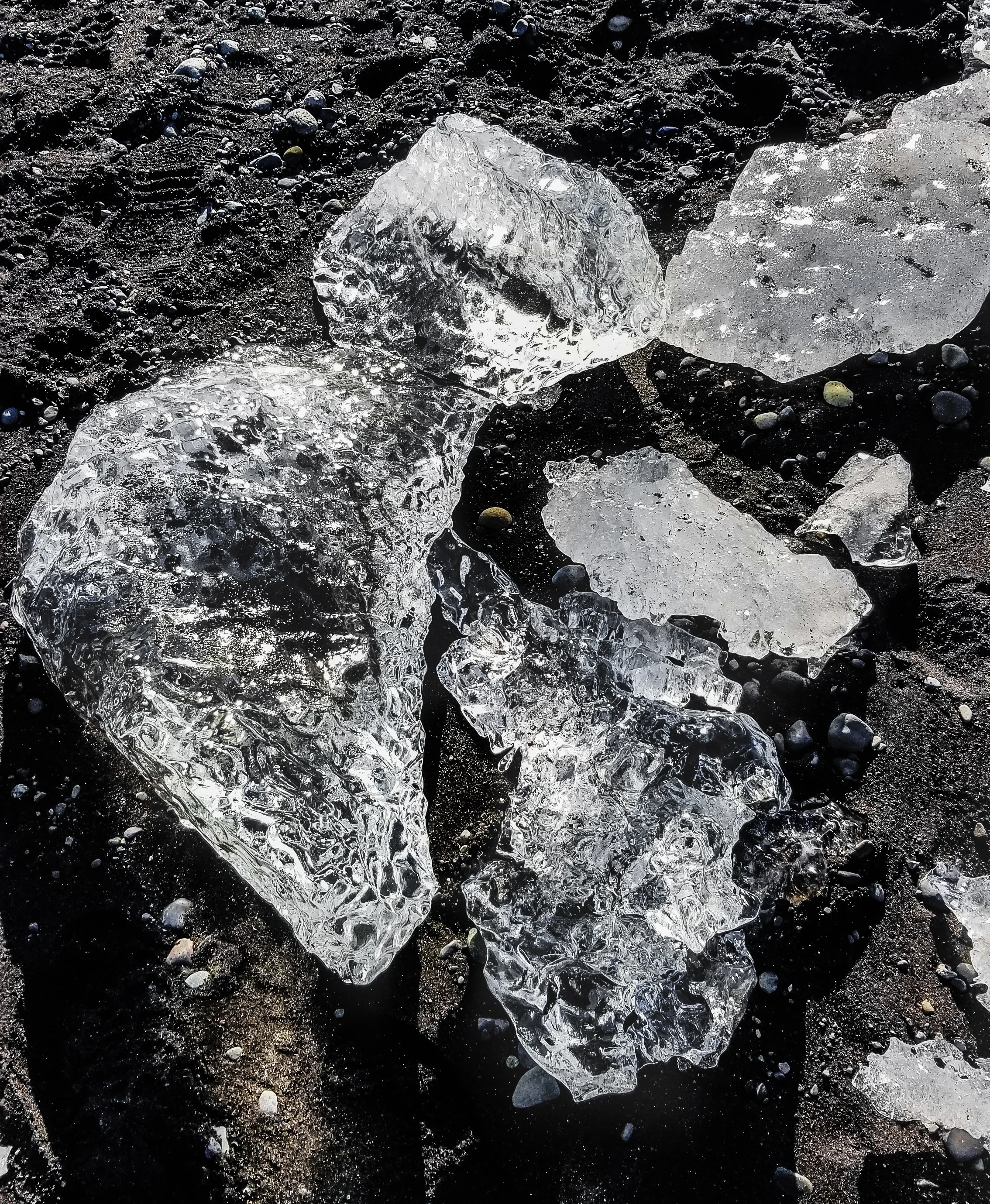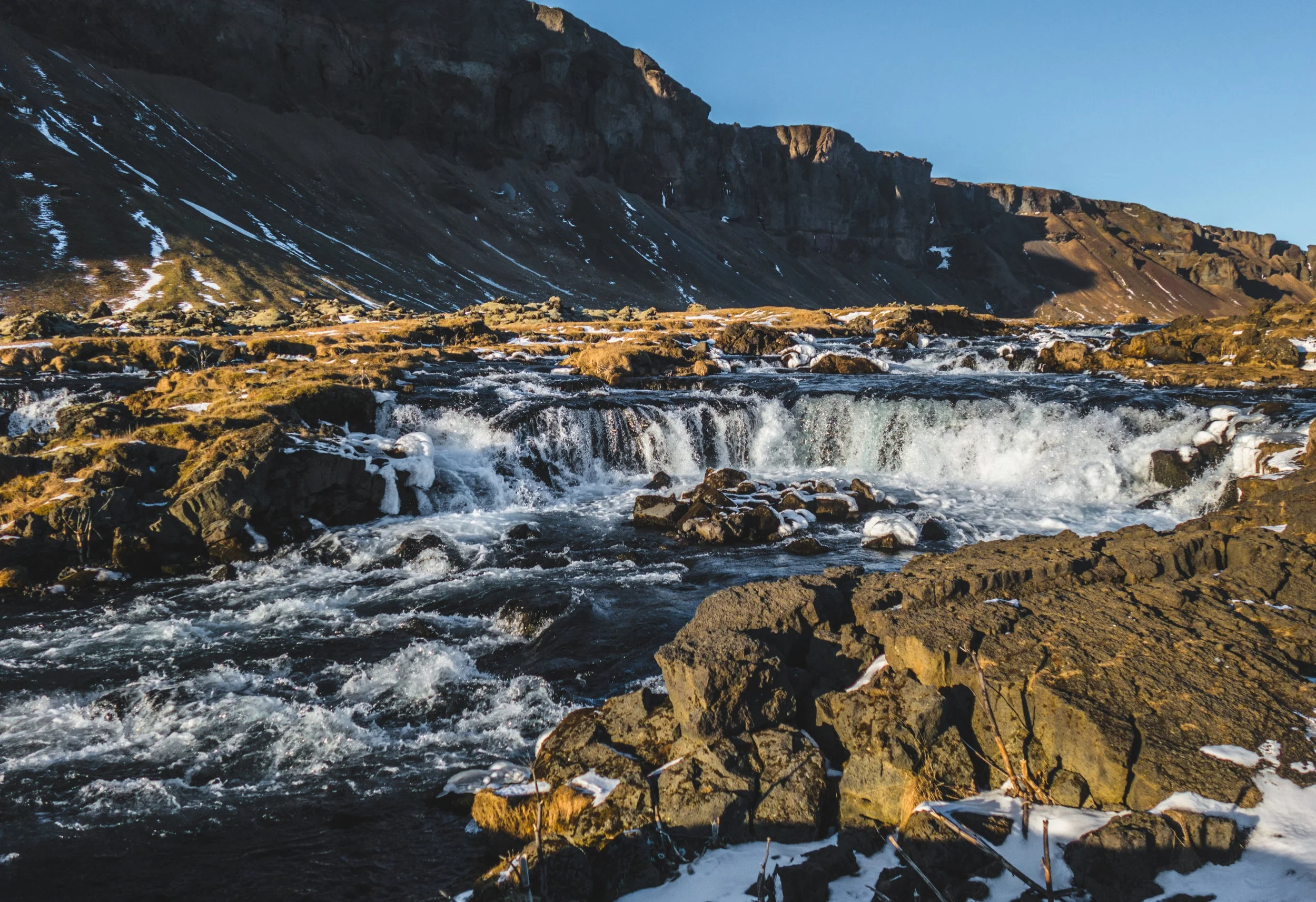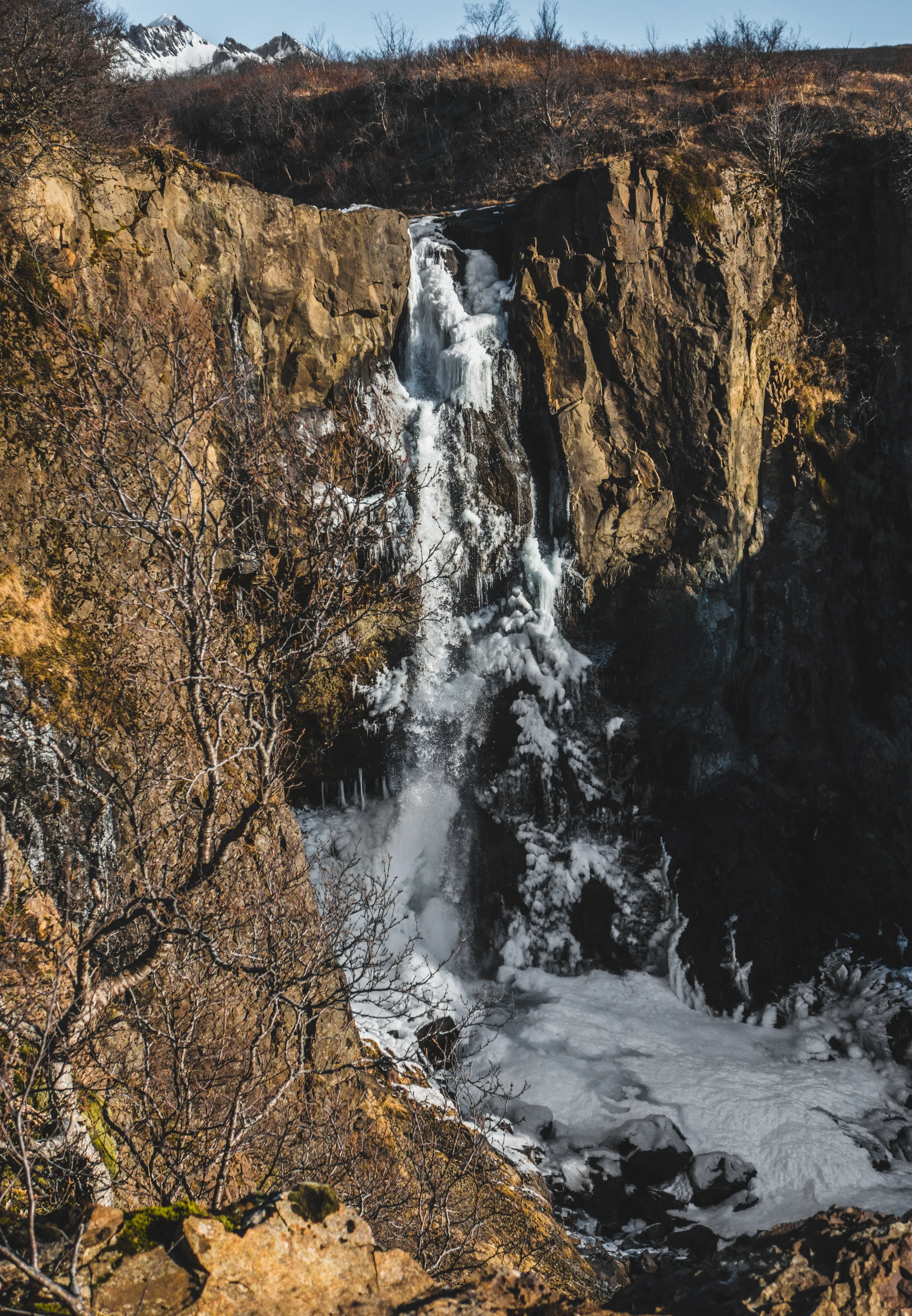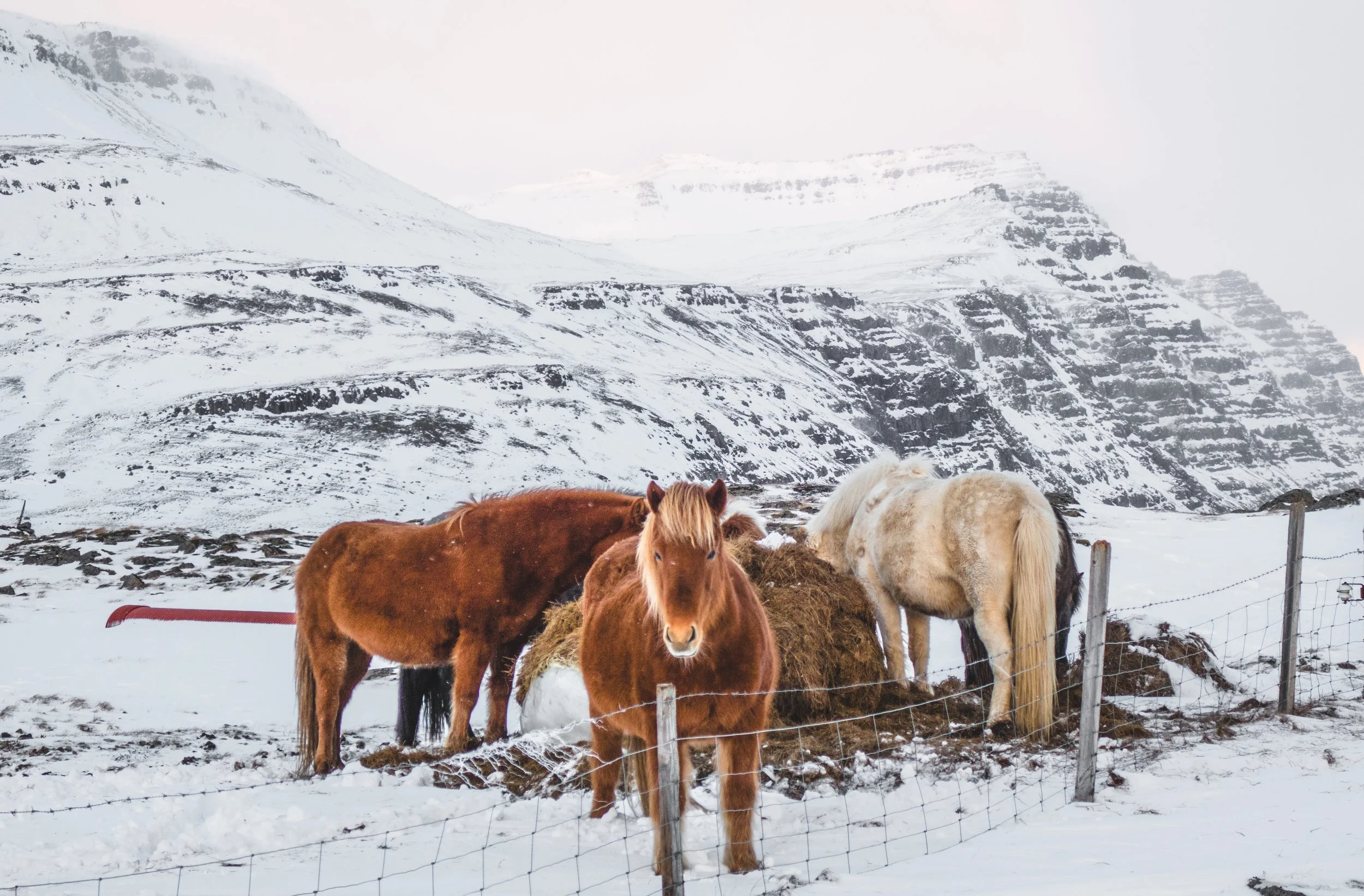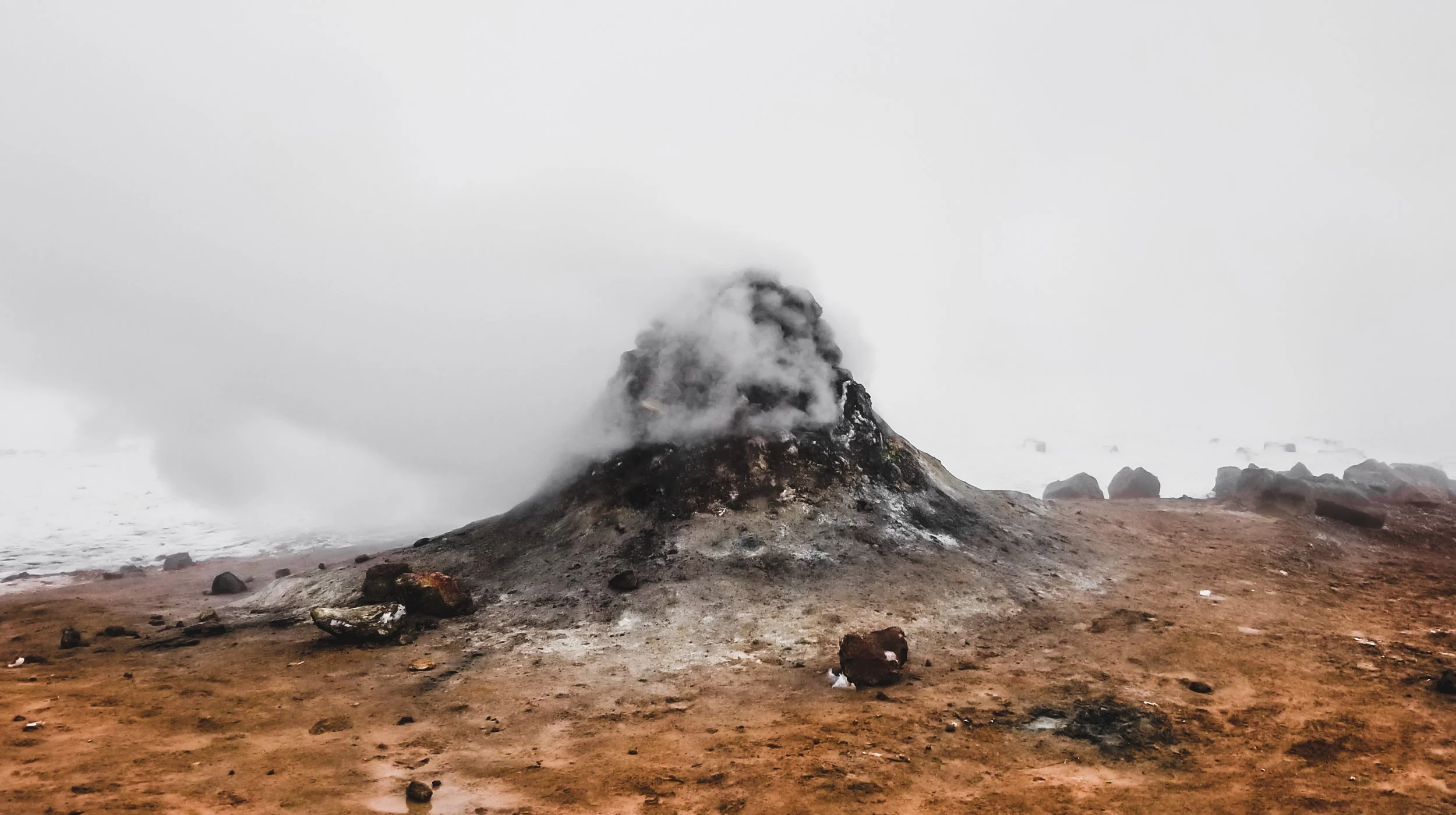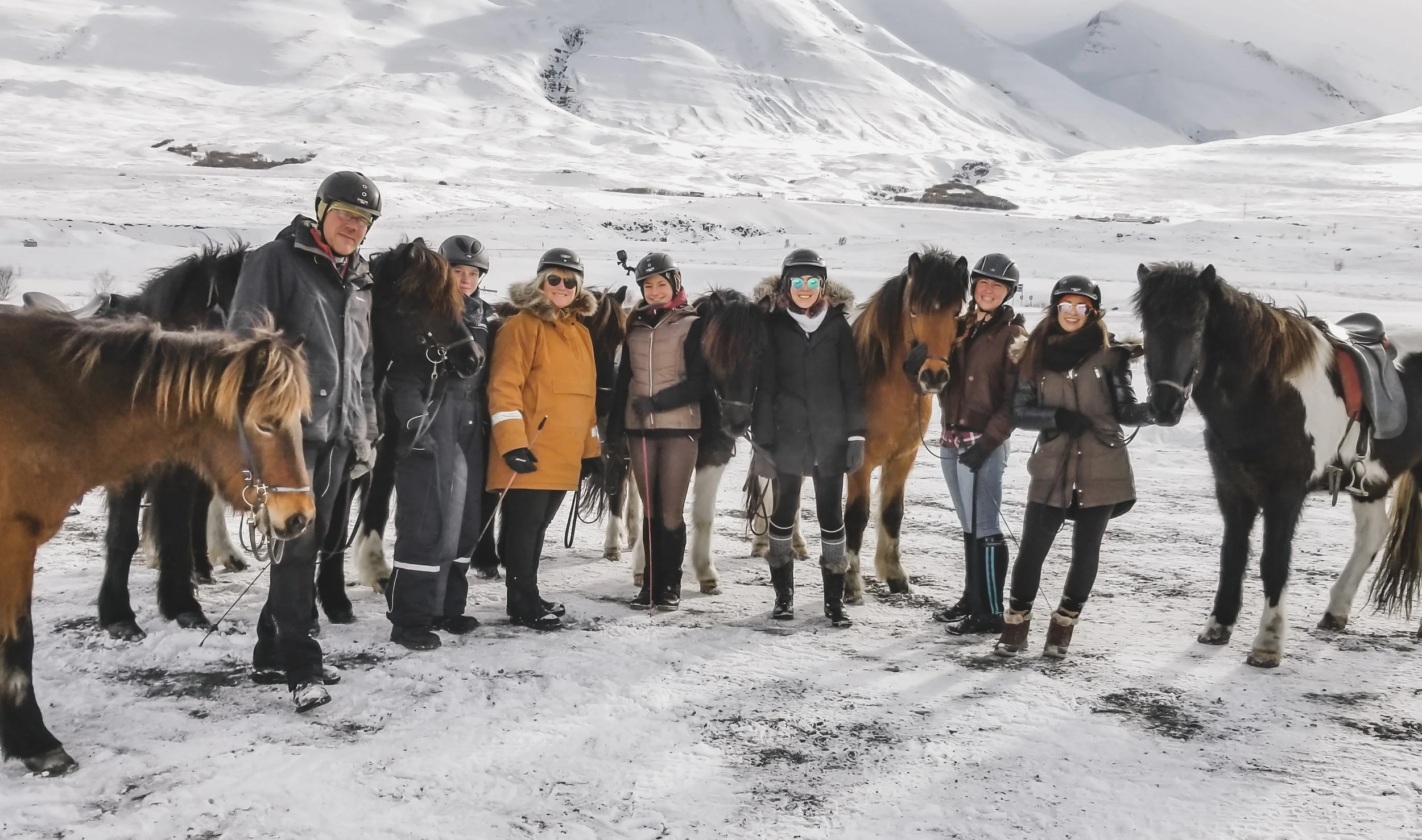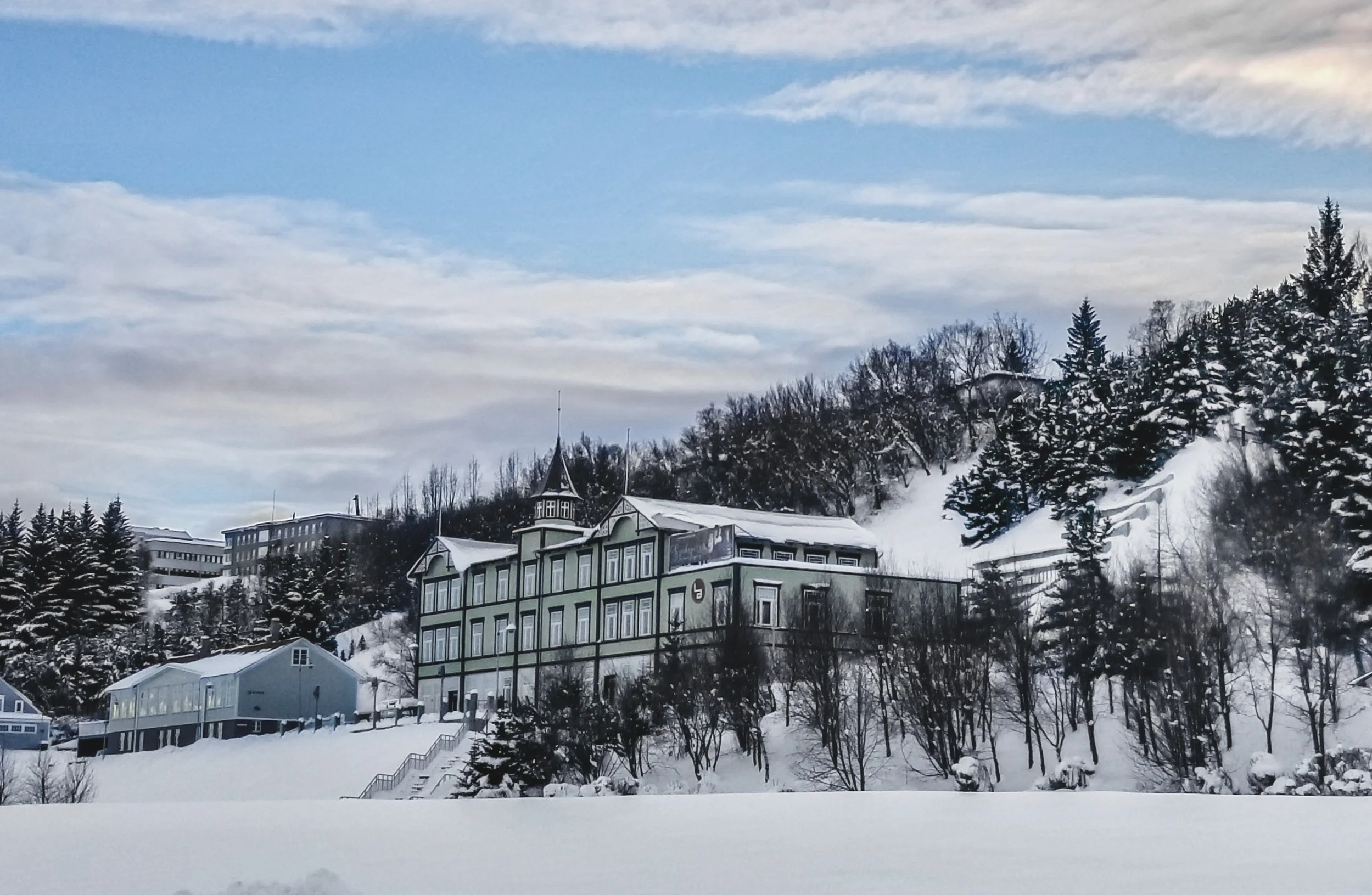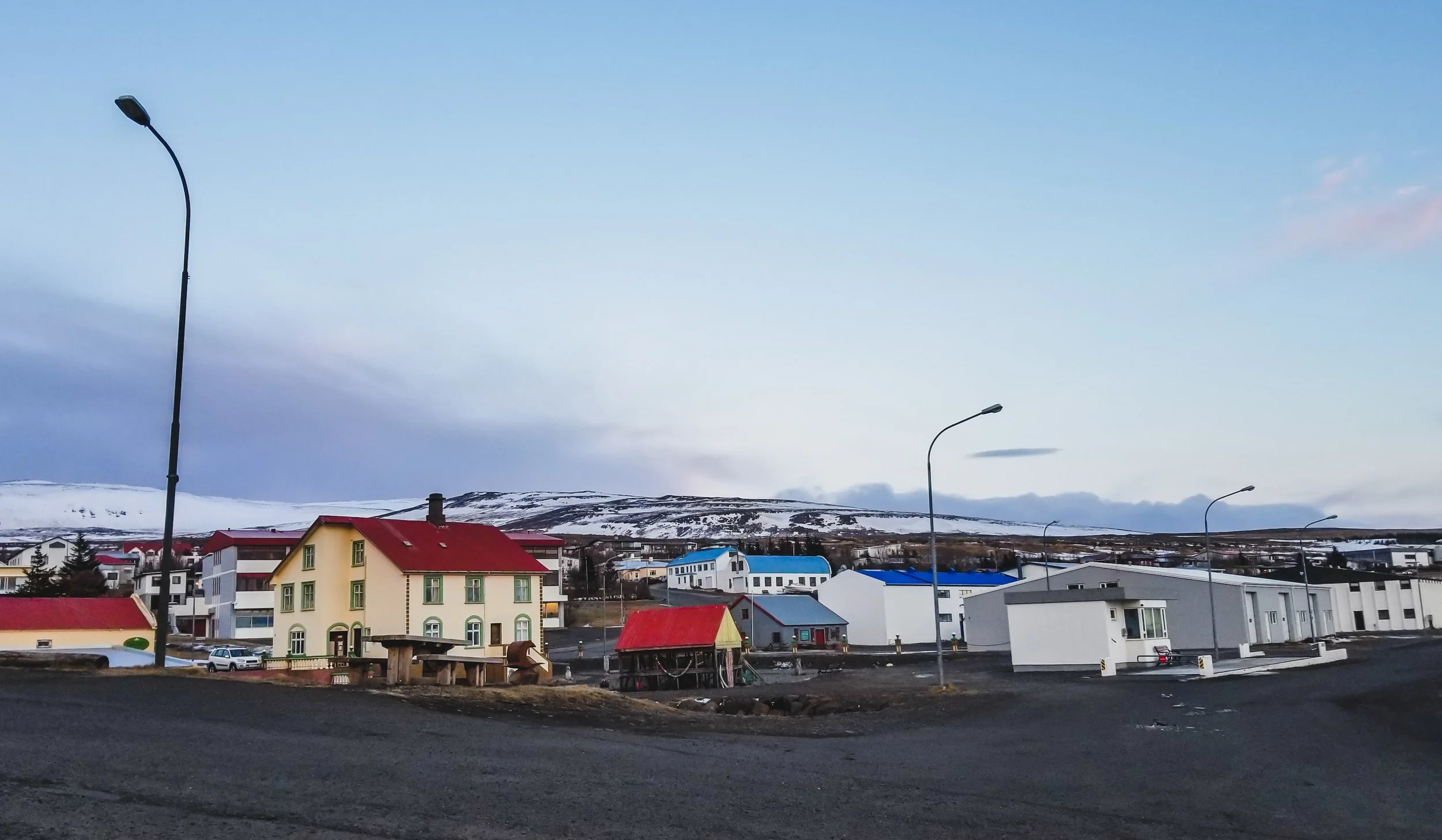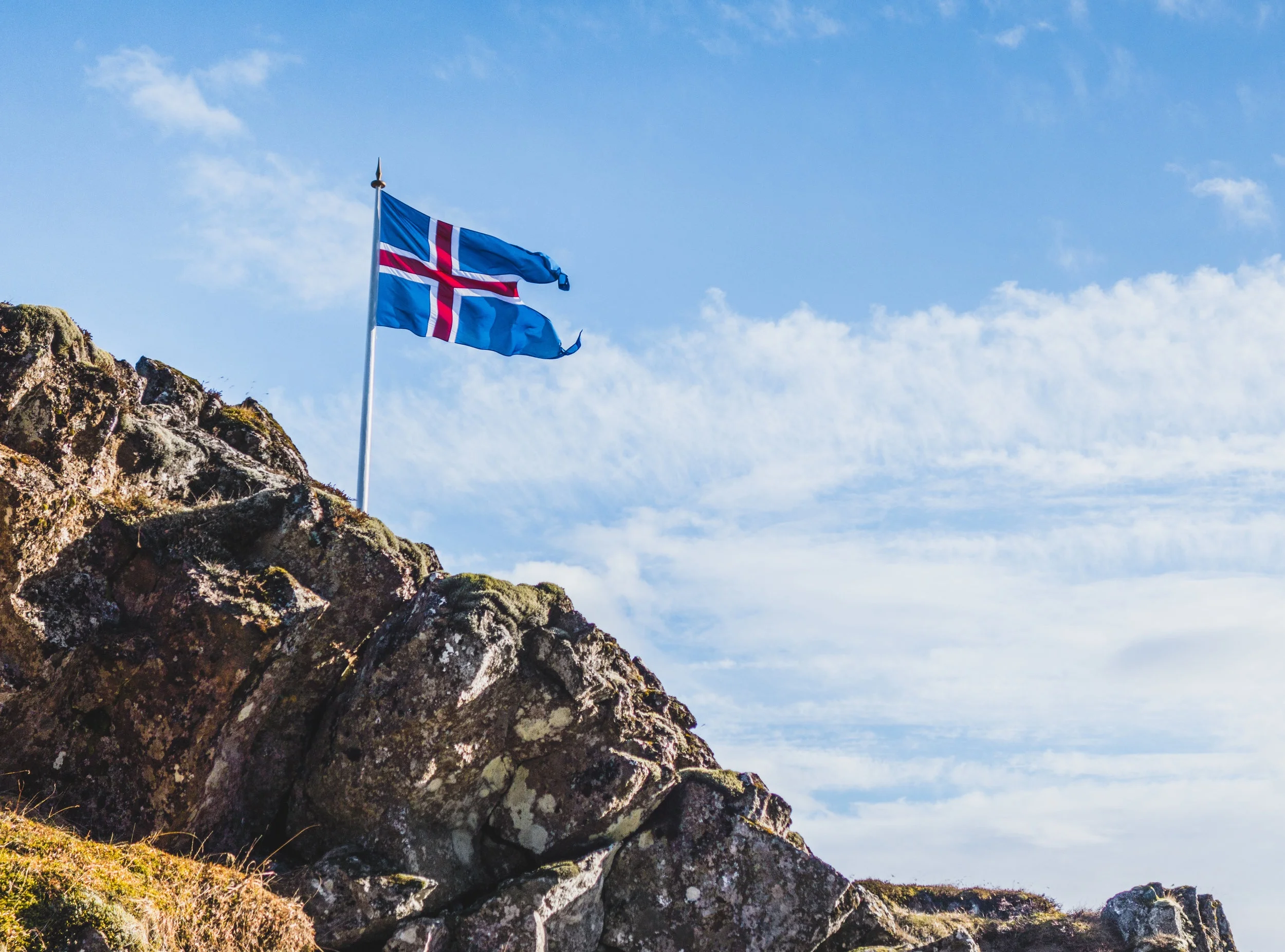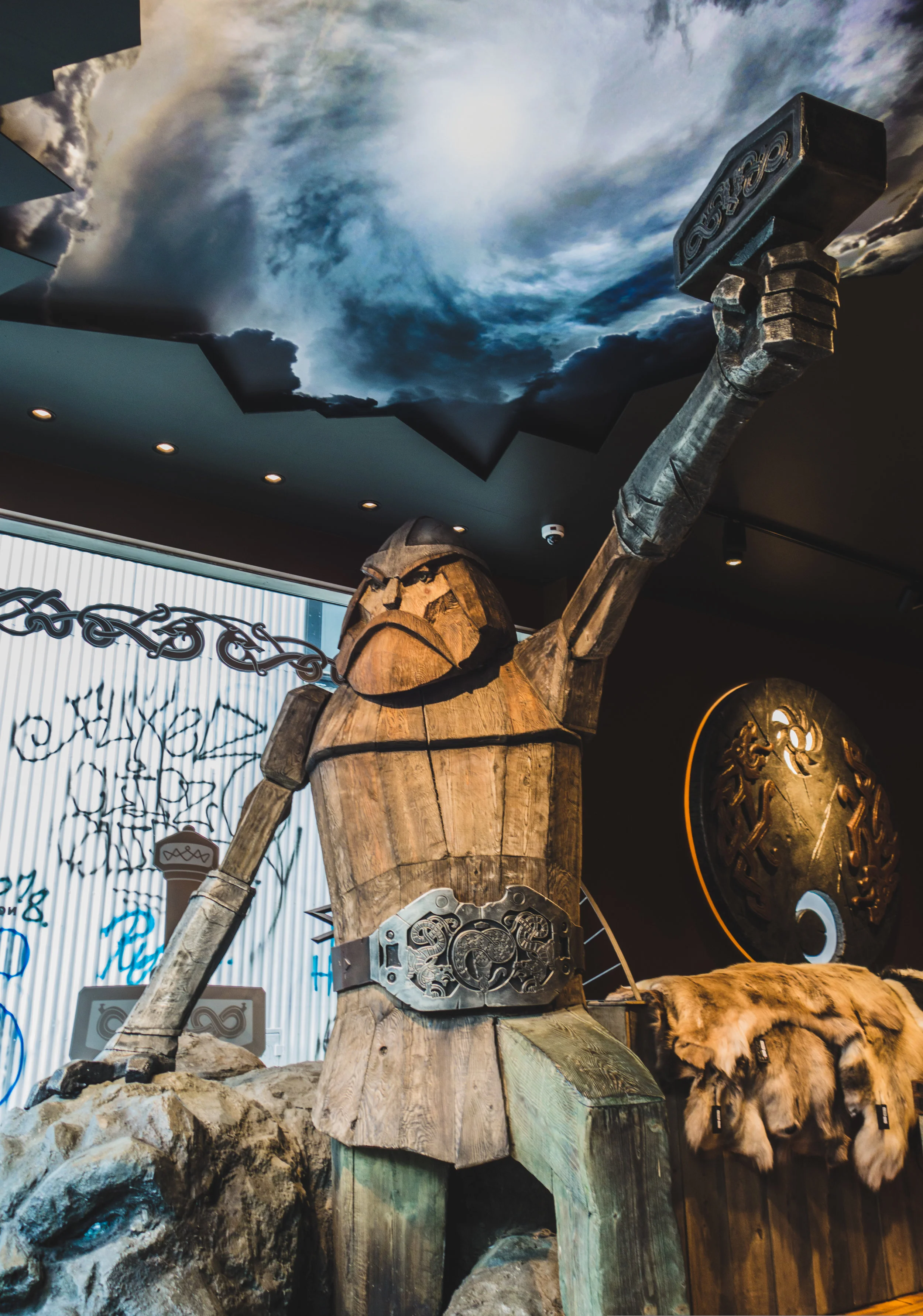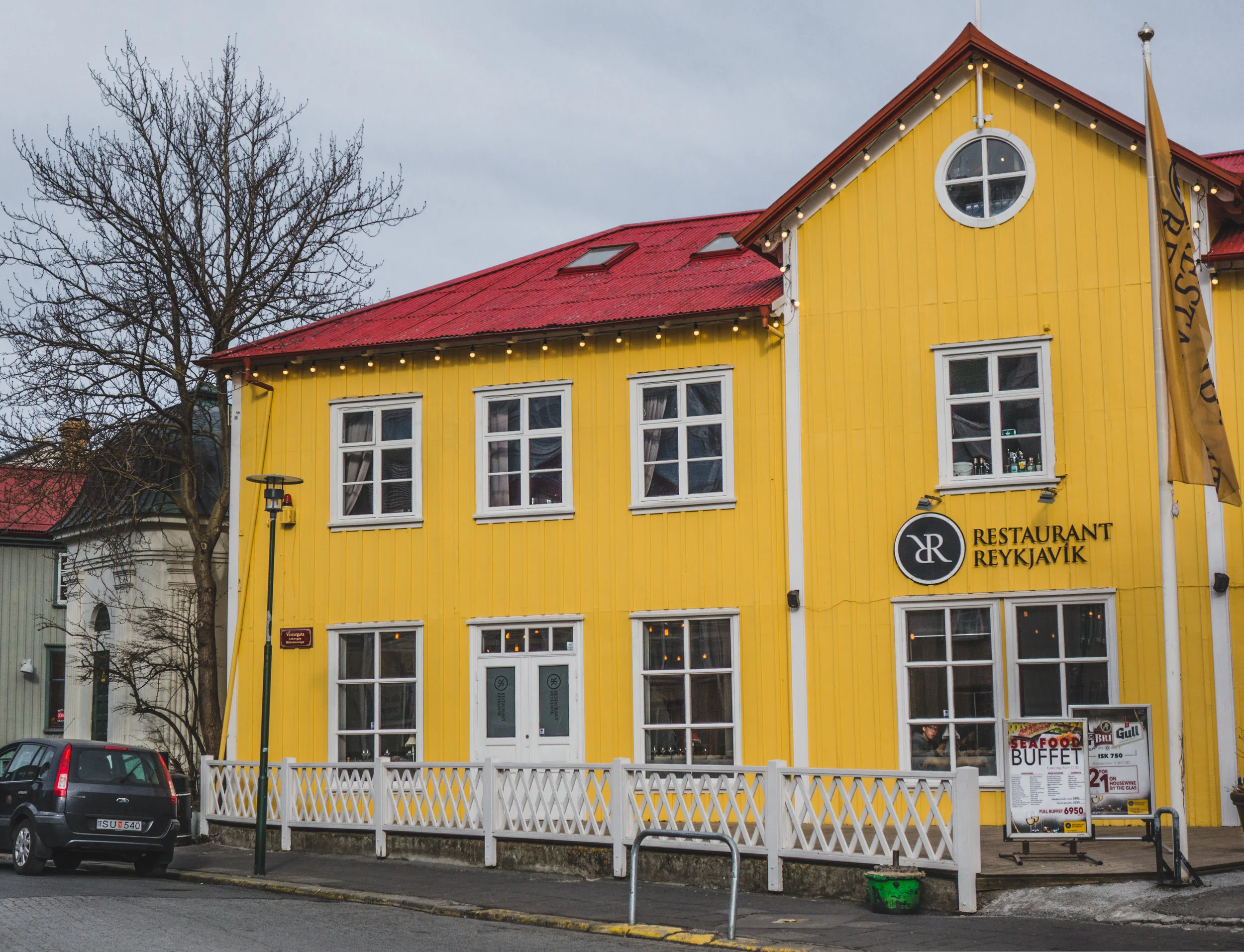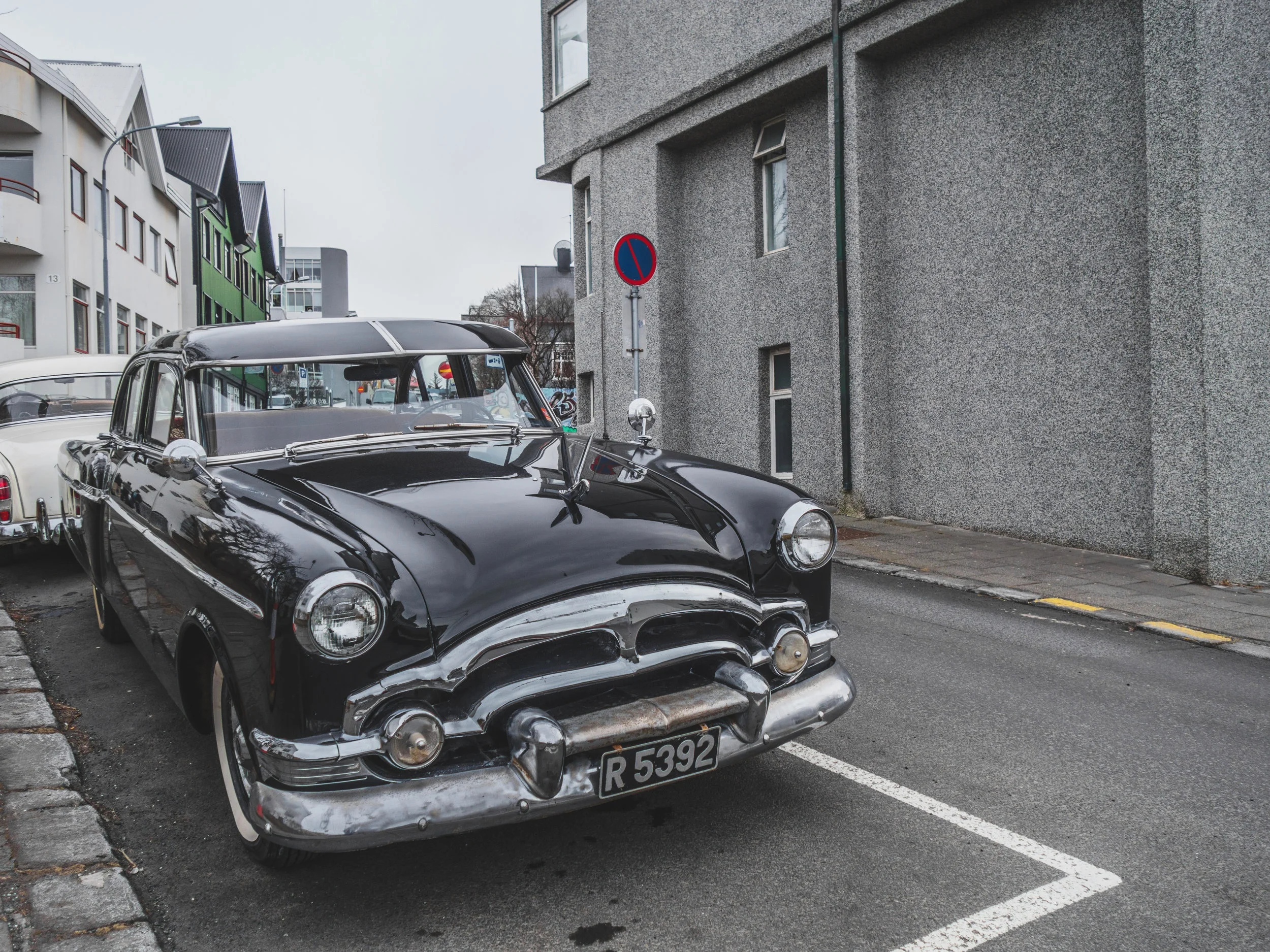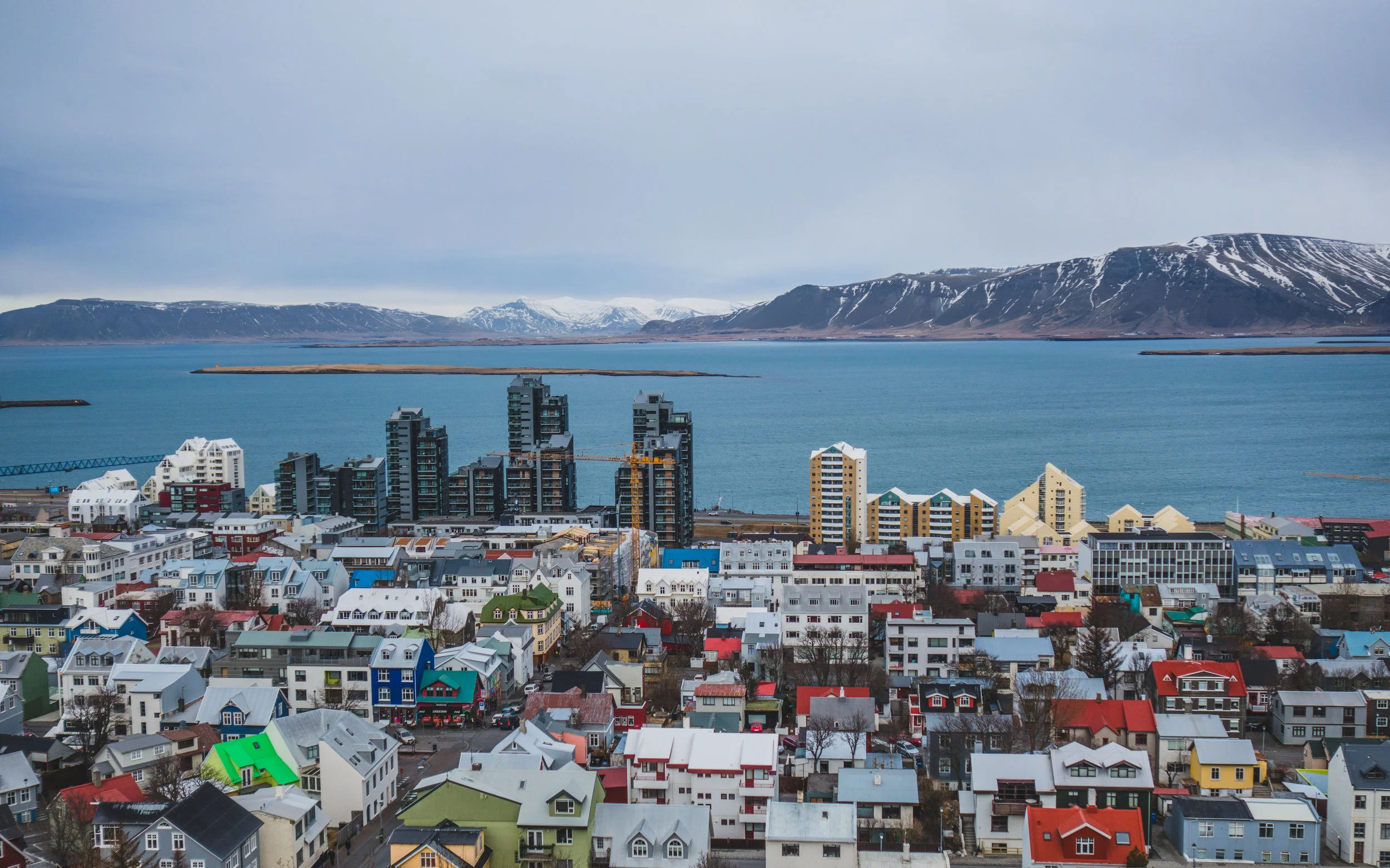Nine Day Roadtrip Guide to Iceland
It was December 22nd, 2018 when my best friend Veronica and I found an amazing deal to Iceland for nine days in March with WOW Air (which apparently has now ceased operation due to bankruptcy - go figure). Just like any other broke millennial, we decided to buy tickets on a whim because the world awaits us! We were so excited but got overwhelmed quickly with the amount of information and amazing locations there were to explore. So we decided to commit fully. If we are going to Iceland, we are going to Iceland! We spent weeks looking at Airbnbs & hostels, researching car rental companies, reading blogs, examining locations, mapping out cohesive routes, creating specific budgets, and spending hours editing that God forsaken itinerary.
We decided that guesthouses and Airbnbs with locals were the best choice for us. Of course these are the best budget-wise, but for us it was very important to meet the people of Iceland and hear their stories! We also wanted to meet other travellers like us and exchange stories.
There were many locations that we didn’t get to see (there is just not enough time to explore the entire grandeur of this magical place in one trip), but there were tons that we did fortunately get to experience - so I accumulated all of the highlights that make a great first roadtrip in Iceland! We took the Ring Road, also known as Route 1 (I will probably use both of these interchangeably), around the island - which is the national road that loops around all of Iceland.
Gulfoss
Geysir Gemothermal Area
Friðheimar
Sólheimar Eco Village
Kerið
Seljalandsfoss
Skógafoss
Reynisfjara Beach
Village of Vík
Svartifoss
Svínafellsjökull
Jökulsárlón Glacier Lagoon
Krafla
Hverarönd
Grjótagjá
Goðafoss
Akureyri
Sundlaugin á Hofsósi
Hvítserkur
Akranes
Þórufoss
Þingvellir National Park
Öxarárfoss
Reykjavík
The Blue Lagoon
Day one: The Golden Circle
We landed at Keflavík airport at around 4:50 am and picked up our car (a Suzuki Jimny) at 6:30 am in the parking lot right beside the airport - it was super convenient. We pre-booked our rental car with Go Iceland Car Rental before our trip and they gave us the option to pick it up from the lot in the city or straight from the airport. With a slight detour to a bank near Reykjavík, we planned to start the day by exploring the Golden Circle route. We decided to start here because as wonderful as the main attractions are, we wanted to “get them out of the way” so to speak, and invest more time into the wilder spots away from the tourist central. My first impression of driving in Iceland was otherworldly; barren, vast, and long stretches of road. It seemed like we were driving in the middle of nowhere for a while to get to locations that seemed to be so prominent when we researched them. It was truly fascinating and extremely different from anywhere I’ve driven before. We adapted quickly and every region was so different from the other, which made for a captivating trip.
Gullfoss (“The Golden Waterfall”)
Get ready to be blown away - literally! An extremely powerful waterfall comes with extremely powerful wind. Gullfoss is probably the most notable waterfall, as it is one of the main highlights on the Golden Circle tour - which of course is the most popular tourist route close to Reykjavík (it took us about an hour and forty minutes to get here). We started off on Route 1 and turned onto Route 35. Route 35 is the stretch of road where most of the Golden Circle attractions lie. We started all the way at the end of the road and made our way back down. Gullfoss is a two part waterfall on the Hvíta Glacier River and all together it is 32 meters high, falling directly into a canyon. The parking lot is beside a visitor center and restaurant, where there is a little footpath you can take to get down to the waterfall - or opt for the viewing platform at the top. At the top there is a memorial of Sigríður Tómasdóttir, who (legend has it) threatened to throw herself into the waterfall to protest against foreign investors that wanted to turn it into a hydroelectric power supply (we didn’t actually spend enough time there to learn the history more in depth but I read this online after). We, of course, were interested in descending as much as we were allowed. It was a tough little traverse though because the path heading down was icy and the wind shows no mercy. Getting a photograph is a whole other story. Achieving these effortless looking shots seen online is no easy task. The wind is so strong here, that it pushes you back and forth, flips your hood up and down (make sure you wear headwear that is secure to your head), and pushes your camera from side to side as you are trying to take a photo. I gave up switching between my GoPro and Sony RX100 (which i’m currently using for my trips) because it is just too much of a challenge to access anything in your bag when you are barely stationary. Even though we physically weren’t able to stay too long (it was also very cold), it was a breathtaking spot to visit and you can’t help but admire the amount of power in your midst. We spent some time looking at all of the interesting items in the gift shop and then we headed to our next destination - ten minutes away and still on Route 35.
Gullfoss
Geysir Geothermal Area
Another popular stop on the Golden Circle tour is the famous Strokkur geysir. I could honestly sit here all day and marvel at the incredible burst of power expelling from the underground reservoir as it comes into contact with hot lava rock. It’s a sight to see and feel in person, there aren’t many words to describe this mesmerizing phenomenon of nature. You just need to visit and truly bask in it. The geysir erupts every five to ten minutes, so if you miss it, don’t worry - it will be back soon! There are several blow holes, hot springs and boiling mud pits in the area, and of course beautiful scenery.
Strokkur Geysir
Friðheimar
As we were getting hungry at this point, our next stop was naturally the family owned tomato and horse farm known for its famous tomato soup. From the geysir, it was 16 minutes down Route 35.
I absolutely loved this place and it’s probably my favourite part of the Golden Circle. The family (Knútur Rafn Ármann, wife Helena Hermundardóttir, and children) runs a fully functioning eco-friendly and sustainable farm, while also operating a restaurant and little tomato shop inside the greenhouse. They also have an equestrian center and tourist services - and I read that they even run horse shows. As we were functioning on a full day of practically no sleep and a few protein bars, we were very much excited for a nice hot bowl of soup. It was a unique experience. We were seated at a table right in front of the tomato vines, beside all of the other tables booming with visitors from different places. When the waiter came along, we already knew what we wanted. The tomato soup was a little pricey (as was mostly everything on the menu), at about $30 cad, but it was absolutely worth it. It turned out that it was essentially all-you-can-eat soup and bread at a little station - it was bliss. It truly was the best tomato soup I have ever had and the bread was so fresh and delicious as well. They were fully committed to tomatoes; the menu literally had tomato flavoured everything on it - including ice cream! During our lunch, we were chatting with the waiter and he explained to us that they use solar energy in the greenhouse and because of the lighting system inside, they are able to grow tomatoes all year round. The family also imports bees and various bugs from Norway to pollinate and drive away pests, that way they don’t need to use any pesticides. I love how much effort they put into their sustainable practices. Once our bellies were full, we spent some time trying to convince the horses outside to come greet us.
Friðheimar greenhouse, restaurant, and shop
Sólheimar (“Home of the Sun”) Eco Village
This one is not on the Golden Circle route but we decided it would be a neat place to stop, as it was nearby. It was an 18 minute drive from Friðheimar, off of Road 354. Sólheimar is a tiny village and sustainable community of about 100 people, focused on the growth and development of humans and nature. It was founded in 1930 and today it consists of: organic greenhouses, an arboretum, a shop, an art gallery, a cafe, a bakery, a church, a sports hall, a gym and swimming pool, a music garden, guesthouses, and art venues. They also have workshops in candle making, ceramics, weaving, carpentry, fine art, paper-making, soaps, shampoos, and lotions! The best part is that they focus on ensuring people with special needs are provided with the same opportunities as everyone else. A good amount of their community are people with special needs and they offer them creative work opportunities that allow them to reach their full potential.
With our luck everything was closed, except for a tiny shop down the hill. We walked around the area for a while though and found a cool sculpture garden and a few art projects. I would definitely love to come back when it is open and get to experience the village when it’s thriving with energy.
In love with the funky benches here
Kerið
Back on the Golden Circle, this one was a sight to see in person. I saw tons of pictures of it online and it seemed like an interesting spot to stop at on the way to the “bigger attractions” of the Golden Circle. After a 14 minute drive, we were back to Route 35. We actually almost skipped this one because at this point the lack of sleep was consuming us, but we powered through and it was basically on our way back to our Airbnb anyways. I am so glad that we made this decision because this place is magical. There is a free gravel parking lot but there is a kiosk beside the parking lot where you pay an entrance fee of 400 isk (about $5 Canadian) - for maintenance of the grounds. You then walk up the stairs to this view (photo below), and there is also a set of stairs that allows you to walk right down to the frozen crater and walk on it (which we did of course). Kerið is a volcanic crater lake - the most popular of several in the area. It is half the age of the other volcanic craters and apparently that’s why it has a rich red colour (due to fresh iron deposits) rather than volcanic black. What’s really interesting is that minerals from the rocks seep into the water (when it’s not frozen) and create an aquamarine colour. If you go when it’s frozen, be sure to spend some time simply admiring the interesting patterns under the ice and sliding around. It’s an incredible piece of nature and photos don’t do it justice!
Kerið Crater
We ended our day in the town of Selfoss (only 14 minutes away from Kerið and back on Route 1), where we saved some money by eating sandwiches for dinner at the gas station near our Airbnb - which were also overpriced. We stayed at an apartment complex right in town, with a charming family and with what seemed like the most comfortable bed in the world (especially after a very uncomfortable flight and a lot of jetlag).
Day two: Adventures in the South
The next morning, we were aiming to head out at 6:00 am to catch a few epic shots of the sunrise from our next destination. We ended up leaving a bit late for our liking, but we were still able to witness the sunrise on our ride there and we had the beautiful light of dawn to work with at our first stop of the day:
Seljalandsfoss
Another well known tourist waterfall is Seljalandsfoss, and it is about an hour from Selfoss. You can actually see it in the distance as you are driving on the Ring Road heading south, and then there is an entrance (left on Road 249) that leads you down to the parking lot. Our strategy was when we see it we turn down the next road, and it worked out for us (a very thoughtful plan). There is a parking fee here - 700 isk (about $9 Canadian), going towards maintenance. We got here quite early so there wasn’t really anyone around and it was also still technically the winter season so there weren’t as many tourists in the area. Since we were amidst the stillness of the day, it was a nice contrast of serenity and the charging power of the 60 meter waterfall at the side of a cliff.
Seljalandsfoss is fed by the ice capped Eyjafjallajökull volcano, which last erupted in 2010! The real highlight of this one is walking behind the waterfall, which makes for some epic shots. That said, I wouldn’t attempt this in the winter unless you have full waterproof gear, spikes on your shoes, and something to protect your camera equipment. There is a set of stairs that let you climb to the top of the waterfall, which were technically closed off because the whole structure was literal ice! The stairs, railing, and pretty much everything around it was coated in a few centimetres of ice (and extremely slippery), and on top of that you have water spewing at you from the waterfall. You will get drenched and you will come out as an icicle like we did. We made it to the top but getting behind was VERY risky. It was a tiny path of ice holding you from your demise and I didn’t feel equipped to make the walk over. Veronica however, did walk over (bless her soul), and made it back alive somehow. I’m all for living on the edge (pun intended) but I wouldn’t advise climbing this one in the winter unless you feel 100% equipped. Nonetheless, the views were phenomenal from all sides and you can get pretty close to the waterfall without having to climb anything.
Seljalandsfoss
Skógafoss
Continuing on Route 1 and turning on Road Skogar - about an hour and 20 minutes from Seljalandsfoss; you’ve probably seen this one all over the internet but it truly is a sight to see in person. It is a beautiful waterfall to photograph and you can essentially get as close to it as you want to (safely of course). It is a very powerful 60 meter waterfall situated on the Skógá River. My favourite part of this one is that it creates a rainbow when the sun conditions are just right - and we got lucky. There is also a path on the right side of the waterfall that you can hike all the way to the top and view it from above. Interestingly, I read that there is a legend that a settler buried his chest of gold under the waterfall!
Funny story about getting here: as we were driving we were looking for any road that turned left, whilst trying to follow our map. We ended up prematurely turning down this super narrow dirt road that took us nowhere (and we had lots of difficulty turning around) … when there is a clearly marked and paved road (and directional signs) a little further up the road (oops). A tip - the large attractions have clear signage so don’t turn on random sketchy roads.
Because Skógafoss is a high traffic tourist area, the prices and hospitality seemed to reflect it. Veronica was feeling pretty hungry (running on protein bars eventually breaks you) so we went into the Hotel Skógafoss restaurant - which was lovely because it overlooked the waterfall. We waited for a while because it didn’t seem like anyone was going to come greet us, so we had to ask someone whether we seat ourselves - and finally we got settled. It all seemed a bit cold. They were getting ready to flip the breakfast buffet for lunch but it would have been nice to at least be greeted with a smile. We love to interact with people on our travels and we felt as though we were bothering them. Regardless, they were responsive enough and Veronica got the last of what was left on the breakfast buffet. I think she had a bagel and a boiled egg or something and I ordered a coffee to keep her company (and to breathe some life back into me), and it came out to be about $30 Canadian!! I’ll still never forget that to this day.
Down the road is the Skógar Museum, which consists of three parts: the folk museum - which displays tools used for fishing and farming and artifacts dating back to the viking age, the turf houses and open-air museum - which shows how the people of Iceland lived throughout the centuries, and the museum of transport - which shows the development of technology and transportation in the 19th and 20th centuries. You can see a lot of the open air museum from the parking lot, especially the turf houses that we were dying to photograph. Personally, we thought the entrance fee was a bit high (it was something like $40 cad) so we decided to take some photos from the parking lot and play with the lovely cat that was greeting all the cars on arrival. Then it was time to head out because we had a date with a certain world famous black beach.
Skógafoss
Reynisfjara Beach
Iceland’s most famous black sand beach. Although it is one of the biggest tourist hubs, it is completely worth going. From Skógafoss, you continue down Route 1 until you turn right on 215 and follow the road all the way down to a parking lot. Side note, parking is free but in old European fashion, the entrances to the bathrooms inside the building next to it are paid!
Reynisfjara Beach is truly astonishing. You feel the power of the waves as they crash into the volcanic shore - that glorious black sand that so many people aim to get their feet on as part of their bucket list. The postcard panoramas here are absolutely stunning.
Reynisfjara exudes serenity and mysticism but it’s not a place to mess with. I found myself very enthralled in watching the water rip and roar in and out but all of the signs everywhere quickly remind you that this is a powerful force of nature. For one, it is a very windy location (naturally). Most of the cliff edges were roped off with clear signs that the possibility of falling (and rock slides) isn’t unlikely. The beach itself is not accessible from the main entrance and they don’t actually recommend anyone goes down to the water because countless times people have been pulled in (and not returned) by the waves. As beautiful as they are, the waves here are sneaker waves - which means they come in very quickly (and sneakily, as the name suggests) and pull you into their rip current. This makes it almost impossible to swim out of and there have been many deaths because of these particular waves in this area. I would suggest observing the views from the top and if you really want to step on the beach, stay far away from the water. Keep in mind, there are many opportunities to step on black sand further along the Ring Road, and even in the surrounding area prior to arriving to Reynisfjara Beach.
There are a few specimens protruding from the water (see photo below) in the distance, called Reynisdrangar. They are composed of basalt and are the remains of old sea cliffs. There is an Icelandic legend that says these were trolls that tried to pull a ship back to the shore, but they got turned into stone because they stayed out too long and the sunlight emerged before they could hide.
First Game of Thrones reference of the trip: this location was featured in Season Seven, Eastwatch by the sea - episode five and six, where the Night’s Watch is guarding the wall.
Reynisfjara Beach and Reynisdrangar in the distance
The Village of Vík
Vík is the Southernmost town/fishing village in Iceland, and it is right along the Ring Road (only 11 minutes from Reynisfjara Beach). It is situated on the coast of the Atlantic ocean, lined by the same black sand we encountered earlier. If you are renting a car, it is definitely worth the drive to Vík (after visiting the beautiful Reynisfjara Beach). It is a picturesque little town, with a church standing high, watching over the town on a hill above. We only stopped for a bit at a grocery store/cafe by the coast because we wanted to make our accommodation before dark/we weren’t sure when the last check in time was, but I would certainly come back to explore the town a little more. It’s a magical little spot and the energy from the ocean is invigorating. You can even see the Reynisdrangar more clearly from the black sand beach along the town.
Vík, Iceland
Our final destination for the day was the Hvoll guesthouse in Kirkjubæjarklaustur, which is a hostel that seemed to be in the middle of nowhere (as many places do in Iceland, ha!). It was off of Route 1 and an hour and nine minutes from Vík. We actually missed the entrance because we didn’t think the dirt road led anywhere (after pulling that stunt near Skógafoss). After a lot of confusion, we found our spot! There is a long rocky road leading up to the buildings; a smaller building where you check in and the main guesthouse down a hill. Sidenote, this place was great because we didn’t have to pay anything in advance, we were able to book it (on booking.com) and pay for it in full when we arrived. The surrounding area was quite serene, as there were essentially two buildings placed in a giant stretch of land - with mountain and lake views, and glorious sunsets that engulf the open space.
The hostel itself was very clean - most notably there was a spot at the front door with many racks where all the guests could put their boots, that way everyone can walk up to their rooms with clean feet. There was a shared kitchen, shared leisure spaces, and shared bathrooms, and we were able to get our own private room - which was ideal! The only downfall was that there wasn’t any warm water when I decided to take a shower so the relaxing hot shower I was dying for had to wait. We actually quite enjoyed the shared spaces downstairs because we met a bunch of other travellers and we all spent the evening sharing stories and running outside to catch the Northern Lights as they played a dim peekaboo with us!
Day three: The East
International Women’s Day…and we celebrated with the most grueling day of the whole trip! This was by far the longest day of the trip and full of emotions. We headed out around 6:00 am and our first stop was a hike at Vatnajökull National Park, which is only 37 minutes from the guesthouse. We headed out on Route 1 and veered left on Road 998.
Svartifoss (“The Black Falls”)
There is so much to see in the Vatnajökull National Park, but we had a very long drive on this day so we opted to just hike up to Svartifoss Waterfall in Skaftafell (the southern part of the park). During the first stretch of our hike, it seemed like we were ascending forever - probably because we were exhausted and malnourished ha! I was out of breath when we hit the top but the views made up for it. The shorter version of the hike is pretty easy and not very daunting - about 3.7 km roundtrip from the Skaftafell Visitor Center. You pass by another beautiful waterfall (Magnúsarfoss) as you head upwards on the trail and another on the trail back (Hundafoss); once you reach the highest point in the trail, you can see Svartifoss from above. You also see a few snow capped glaciers from here. There is another trail that allows you to safely climb down to the falls (it was quite slippery though, so be mindful). You can stop halfway down, where there is a suspension bridge you can stand on for a direct view of the falls, or you can go straight down to a viewing platform at the base. From the platform at the base, it’s also easy (and safe enough) to climb all the way down to the rocks below to the stand right beside the falls.
Svartifoss is known as “The Black Falls” because of the black basalt formations surrounding it, and it is about 20 meters high. I absolutely love this waterfall because of nature’s intricate patterning all around it and the way the icicles hang and glisten in the sun. When I take photographs, patterns are one of my favourite aspects to work with.
Keep in mind that there is a parking fee at the visitor center. I think it was about 700 isk (about $9 Canadian).
Svartifoss
Svínafellsjökull
Another quick stop we just had to make in Skaftafell was Svínafellsjökull. From the visitor center you drive back to Route 1 and turn down the next road. It is a 17 minute drive between them - mostly because the road driving down to Svínafellsjökull is quite long.
Getting here was challenging. To say the road was full of potholes is an understatement; i’d say more so giant craters. It is a long stretch of road, mainly all unpaved, so be prepared with good tires and accepting that your car will get pummeled with gravel. The final destination was completely worth it though! This location is so grand and jaw dropping, which is probably why it is one of the highlighted Game of Thrones filming locations for Beyond the Wall in Season Two and Three.
Svínafellsjökull is actually a “glacier tongue” of Vatnajökull - which is the largest glacier in all of Europe. This means it is a large chunk of the main glacier, that is falling from the top and down a long slope - very slowly because it is such a large mass. The best part of sitting here and taking it in is listening to the ice breaking apart and cracking due to this phenomenon - it is enough to raise the hair on your arms at the force. The beautiful glistening turquoise on top of the ice creates an absolutely picture perfect moment. To be honest, I spent more time just sitting here and basking in my surroundings rather than taking photos.
The rocks themselves were fascinating as well. We safely climbed the ledge (on the left in the photo below) as high as we could and we sat for a while, catching our breath and embracing the majestic energy blanketing us. As we sat I observed the rocks (a habit of mine - the nerd in me loves to search for cool specimens). We found tons of rocks intertwined with beautiful quartz and various other crystals.
Svínafellsjökull
Our minds were already exploding with forces beyond anything we could have imagined, and it was only around 10:00 am. The day started out beautifully but it was about to get crazier in the coming hours.
Jökulsárlón Glacier Lagoon
We actually discovered this one on a whim. We were driving down the coast on Route 1 (heading north) and we saw a vibrant blue stretch of water that drew us to a halt. This was 54 minutes from Svínafellsjökull.
We admired this stunning glacial water and then looked across the highway, noticing another beautiful black beach. We drove over to get our feet in the black sand and to our surprise the beach was full of ice chunks in all shapes and sizes. It was quite fascinating and the sun glistening on each one’s unique pattern made the experience that much more radiant. There were quite a few people stopped here but certainly less touristy than we imagined the ‘Diamond Beach’ would be (and no grandmas floating away on ice chunks). On that topic - one of the major warnings in Iceland: don’t sit or stand on any iced mass because it could easily be pulled back into the water and float away.
Jökulsárlón Ice Beach
From here, we ended up driving about four and a half hours to get to our next Airbnb in Egilsstaðir, which is an Eastern town on the banks of the Lagarfljót river. It was actually supposed to be a shorter drive but the road we were going to take wasn’t safe due to the weather so we had to follow Route 1 all the way around (luckily the town was right outside of Route 1). We didn’t make too many stops on the way because we had such a long journey and didn’t want to navigate unknown roads in the dark. We also passed through our first long tunnel on route - the Fáskrúðsfjarðargöng tunnel (try pronouncing that one as an outsider), 5.9 km through the mountainous land.
This was probably the most mesmerizing and terrifying day of the entire trip. The wind was picking up a lot on the coast and as we continued on, it was partnered with slippery roads and a full blown (no visibility) snow storm near the end - as it got dark of course. Factor in these conditions, and then place them on small roads on the edge of mountains with trucks flying around the bends and you have one giant panic attack. When people say you can encounter season changes on your one week trip to Iceland, they are not exaggerating.
The road to our Airbnb was absolutely terrifying. Everything was covered in snow and it seemed like we were in the middle of nowhere (once again) in the dead of winter. It was already dark at this point and we couldn’t see in front, behind, to the side, above, below, nothing. Turns out we drove on a few narrow roads with a river beside us for a while - who knew. When we pulled in to our accommodation, we even got our 4x4 stuck in the snow! Yup fully stuck! Luckily the hosts realized we were out there and they graciously came and helped us maneuver ourselves over to the house we were staying in. They had actually plowed the area earlier that day but it snowed so much that it piled up again! Once we were (very gleefully) out of the car at last, we were greeted by the most adorable golden retriever and it put a huge smile on our face, along with the extreme kindness by our host family. Even though it was quite late, they helped us bring in our bags, made sure we were comfortable, and even sat with us for a bit - chatting about life and the history of their land. I felt entirely at home and got some amazing sleep that night, cuddling with one of the friendly resident cats! The next morning, we decided it would be the first day we would sleep in a bit, as our next few destinations and Airbnb were not too far from where we were. We woke up to fresh homemade bread - some of the best I’ve ever had! I will never forget the memories we made here (in such a short time) and the stories we all shared with one another. This is definitely an Airbnb close to my heart and we aim to come back one day (and back to Egilsstaðir), as our hosts were giving us some advice on local spots to check out. Unfortunately our itinerary only allowed us to stay a night.
Day four and five:North
We were sad to leave Egilsstaðir but it was a sunny new day and time for more exploring! We realized how different the surroundings were from the night before and it made us laugh that we were so frightened. We made a grocery and gas stop in town and we were off to another series of exciting (and snow filled) adventures. It was quite mind blowing to start a journey on a day where most of the snow you see is only on the snow capped mountains in the distance, to waking up the next day and everything around you is covered in excessive snow. It certainly humbles you and makes you realize you’re at nature’s mercy.
We were back on the Ring Road for about two hours - with a hilarious story in between. Veronica took on the first stretch of driving and I was sitting in the passenger seat foolishly drinking a lot of fluids. At one point we were driving around never ending snowy fields and mountains and I had to use the bathroom. I held it in until I just couldn’t. Long story short, there was literally nothing around and we didn’t see a car for a very long time, so (with no other choice) I had to literally crouch in an open field behind a sign - which certainly wasn’t hiding anything at all. And of course this exact moment happens to be the first time within the hour that a car passes us (sorry not sorry to that car for probably mooning, whilst cringing in terror).
Krafla
Our first stop was Krafla and the Viti Crater, which is a really fascinating place. It is right off of Route 1, with signs directing you to the entrance. As we researched this spot prior to the trip, we knew it was better viewed in the summer; nonetheless, we figured it would still be interesting to check along our route. Krafla is a volcanic region in the North, full of steaming lava fields and craters caused by volcanic eruptions.
The drive was pretty interesting. Upon driving down the road you see a massive amount of smoke floating up to the sky, and once you reach the entrance you realize the smoke is coming from the geothermal power station onsite (utilizing the active lava fields here). The entrance consists of a big arch created by giant pipes that are attached to the geothermal station. There is also a lot of steam coming from the streams nearby and from the land in the distance. Since everything was covered in a lot of snow, the activity of the volcanic fields wasn’t as prominent as it is in the summer months. I do believe that they use this geothermal energy to power the nearby towns but it didn’t seem as though the visitor center was open during the winter for us to learn more. There was a short drive up a mountain to get to the lava fields and the crater, which seems simple enough, but in the winter it is pretty challenging. There was a lot of snow, very narrow roads, and no signs - we basically just followed the road upwards until we saw other people. There is a point in the road where we stopped before we reached the top because we didn’t think we could make it past the deep snow, and it also looked like we were going to tumble down the side of the cliff since there were no guardrails anywhere (and it was a slippery road up). Several other cars were parked on the side of the road at this point because they could not make it up. We decided to risk it (in complete terror) and power through - we didn’t get a 4x4 for no reason! At the top, we had no idea where to stop so we just parked on the side of the road alongside a couple of other cars and the few of us that just arrived essentially followed a trail (if you can call it that) that seemed to contain fresh footsteps. The first part of the trail was eerie but amazing (made for mystical photos) because the air was filled with smog and we were surrounded by snow, quickly losing view of our horizon. The sky and the ground seemed to blend into one giant whiteout. Heading up to the crater was quite slippery as well but as I was watching my feet, I picked up a few lava stones on the way.
The Viti Crater (“The Crater of Hell”) was formed by a huge volcanic eruption in 1724, that lasted five years. When we reached it, it was covered by snow and ice, as opposed to its turquoise blue water in the summer. The views were still beautiful from that peak nonetheless.
Honestly, I wouldn’t suggest coming here in the winter. You are surrounded by great views but you don’t get the full appeal of the phenomenon because everything is covered. And also, it’s a pretty dangerous drive as I mentioned. If you do still want to check it out in the winter months, make sure you have a good winter vehicle.
Hiking up to the Viti Crater - this terrain was a lot more slippery than it looks
The real entertainment was on our way down. There was a little gravel section of land hanging off the cliff where there were a few signs explaining the area. The snow was very deep to get down to it but we decided to risk it. Fast forward a few seconds and our car was stuck half way down! Like, extremely stuck - the snow consumed our tires. I kid you not, we gathered everything we could find in the car that could act as a shovel and went at it for a very long time (along with pushing the car)… to the point where we lost hope and any power left in our bodies. Finally, with a little bit of luck and staying as positive as we could, a family from South America noticed our struggle and drove over to help us dig out and push the car. Now picture this, a bunch of us pushing a jeep down a cliff with no guard rails, as one of us is flooring it and hoping it will stop. God was on our side that day because we managed to get the car down to the signs - quickly realizing that there was a spot with less snow we could have used to get down, which we used to get ourselves back up safely after we read the signs ha! Yes, we still read the signs since we almost killed ourselves to get to them. Krafla was a fun time.
Krafla is east of lake Mývatn (Iceland’s fourth largest body of water) and on the Diamond Circle route - which is a popular spot in the North. The Diamond Circle is essentially the North’s version of the Golden Circle and covers the lake Mývatn area, as there is a lot to see: geothermal baths and caves, lava fields, rare bird watching, cool rock formations, waterfalls, and so on. And apparently it is the Northern Lights capital of Iceland. In the future, I would love to see more of this area. We were hoping to see the powerful Dettifoss - which is the waterfall with the greatest volume in Europe, but due to the winter road conditions, the road was closed off.
Hverarönd Hverir
Hverir is one of my favourite places from the whole trip! It is also part of the Diamond Circle tour and it is 12 minutes away from Krafla - you head back onto to Route 1 and turn left on the next road (you’ll see another area where smoke is rising). This place is truly out of this world; a piece of Mars on Earth and full of life with its obnoxious bubbling and smoking. It lies at the base of Námafjall Mountain and it is an area of hot springs, boiling mud pools, and steaming fumaroles (vents in the Earth’s surface from which smoke and volcanic gases are released). I found this so fascinating - how this space is brought to life through the reactions of elements. This location seemed to be so different from anything else we had seen so far and i’m always fascinated by the weird and unusual. Be warned though, the mud springs are sulphurous, so the entire area very offensively reeks of rotten eggs. I imagine that the fumes probably aren’t the best to inhale either, so I wouldn’t spend all day here.
Hverir fumaroles
As we were driving closer to Lake Mývatn, the views were so spectacular in that region that my breath and words were taken away - cue in the ineffable part of the blog name. We had to stop the car and get out to rub our eyes and wonder if we were still on this planet.
Magical views and the Hverfjall Volcano in the background - to the right (which you can actually hike)
Grjótagjá
The famous “love cave” from Game of Thrones, which was only seven minutes from Hverir. It took us double the time to find this cave because you would never know it’s there. As you enter the road it’s on, you don’t have to drive too far in to reach it. You basically turn right onto the first parking lot area you see (where the other cars are - duh). Since we didn’t see anything that resembled a cave, we ended up driving the entire stretch of road - which essentially loops around and takes you back on the main road. Once we found the entrance again, we stopped at that parking lot to try and figure out where this cave lies. It is fascinating because you reach a wall of rocks right beside the parking area and all you see is a tiny black hole. There was no chance I was descending into a tiny black space I thought; it looked like something out of a nightmare. Veronica however, was adamant on seeing the cave where Jon Snow and Yigrette sealed the deal, and took a few steps down. The rocks are very uneven and it’s a little physically challenging to get down but it wasn’t as terrifying or dark as it masks itself to be from the outside. Once you hit the bottom, that’s where the true hidden gem lies. The crisp blue geothermal water and stunning swirled patterns on the stones surrounding it truly made for an enchanting experience. You can also dip your feet into the warm water.
Fun fact about the cave, it was known to be home to an outlaw named Jón Markússon in the 18th century. Because of the jagged rocks, darkness, and reputation for trolls, it was a perfect spot for other outlaws (that were ostracized by parliament) to gather because law abiding citizens refused to venture in for a while. Locals bathed in the cave for many years until the Krafla volcano erupted so many times that it heated the water extensively and released toxic gases. Apparently the temperature decreased but they still advise not to bathe fully in the water, as it can still contain the gases.
The family we stayed with at our next accommodation told us they actually used to bathe here every Christmas.
An update: I didn’t provide the road name because unfortunately the cave is closed for now, since many visitors sadly did not do their part to be respectful of their surroundings.
Grjótagjá
Goðafoss
“The Waterfall of the Gods” on the Skjálfandafljót River was our last stop before we headed to our home for the night. It is directly on Route 1 (47 minutes from Grjótagjá), and is another popular destination in the Lake Mývatn area. Goðafoss actually has some interesting history. In the year 999, a holy man named Þorgeir made Christianity the official religion of Iceland and he tossed Pagan statues into the water here to commemorate this change, so now Goðafoss is a symbolic site of Iceland’s religious conversion. Getting here is pretty easy, as it is right off of the Ring Road. There is a parking lot beside the waterfall that allows you to park right next to it and walk over, and there is also a restaurant nearby if you need to recharge. You will also get plenty of opportunity to recharge by standing next to the powerful body of water and watch it work its magic. We were just stopping by quickly, but I do believe that there are more ways to see it and trails you can hike to view it from the base (as you can see the photographer standing below).
Goðafoss
After enjoying another famous Icelandic waterfall, we continued down the Ring Road as we set out for our Airbnb in the hills above the city of Akureyri. It is a 31 minute drive from Goðafoss and you don’t need to get off Route 1 because it goes right through Akureyri (and our Airbnb was right off of it as well).
As we approached Akureyri, the view was spectacular. We were surrounded by the coast and in the distance the entire beautifully lit fishing hub gleamed in the distance, with a mighty ski hill situated behind it.
I LOVE THIS CITY. Everything about it. But i’ll get to that in a bit.
We quickly drove through town, admiring the atmosphere on the way as we headed up the mountain to a working horse farm about 20 minutes away. Even though it was getting dark as we pulled up the snowy hill to the farm, we noticed that we were surrounded by mountains. This was going to be quite the scenery to wake up to. We were graciously greeted by an adorable border collie and the host’s daughter as we arrived. The room we stayed in was a bit small, which is no problem for us - we’re not picky, but our suitcases on the other hand needed a lot of shimmying. Somehow we managed to squeeze everything in the room, albeit only one person could go through their suitcase at a time. It was a little awkward at first because it basically felt as though we were imposing on someone’s home, as our room was situated right in the middle of the rest of the family rooms. Being a working farm, they actually hire a few volunteers to stay with them and help work with the horses. Therefore, it was us, the family of five (including a baby) and two volunteers. Once we broke the ice however, we felt comfortable and spent the night chatting and playing board games with all the girls.
That night, I was so thankful for a shower - even though it still wasn’t as warm as I was hoping for, but it was refreshing and much needed and I couldn’t complain at all. I was so exhausted afterwards and got into my pajamas, ready to curl up in bed to relax a bit.
Not yet Martina. Time to get back up. I was startled at the sound of Veronica screaming at me and telling me to immediately go outside. I resisted until I realized something epic was happening. I put a million layers over my pajamas and ran out the door… and suddenly I was surrounded by notes of green and purple dancing around the sky. This was it. I was speechless, emotional, and so extremely grateful that the Northern Lights decided to not only grace us with they presence but dance around long enough for us to get the true immersive experience. I went to bed that night feeling ecstatic that I got to witness a wonder of the world that was high on my bucket list.
The next day we paid our hosts for an hour of horseback riding (when in Iceland) and they ended up graciously taking us with them on their family horseback outing for two hours! I was right, the mountainous scenery was something to behold. As someone who has ridden horses many times before, this was still quite the interesting experience. Icelandic horses are different from any other horse, as they have five gaits instead of three. They are smaller than most horses but they make up for it in sass and energy. If the Icelandic horse wants to go, you will certainly not be the one to restrict them. Our ride was interesting because the horses are used to accelerating very quickly (which is a specific characteristic of Icelandic horses) and moving through their familiar environment with ease, but for us a snowy mountainous terrain didn’t exactly scream “speed”. As it was Veronica’s second time on a horse, the ride was a bit intimidating at times (I also found it intimidating) - kept things exciting though (to the others at least ha!).
After our ride, we decided to embark on more relaxing activities - trying out a restaurant in town and some wandering!
Akureyri
Akureyri is Iceland’s second largest city after Reykjavík, but still only has a population of about 18,000. It lies at the bottom of the Eyjafjörður fjord - which is one of the largest fjords in Iceland (over 70 km in length). It is a colourful and picture perfect city that’s booming with: restaurants, breweries, art galleries, museums, cafes, a botanical garden with a very large species of flora, swimming pools, trails, preserved old houses, golf courses, ice cream shops, a beautiful church, accommodations, an epic ski hill, and apparently the best location for whale watching! The streetlights in the city are even shaped like hearts! Yes, literal glowing hearts. Sigh. Everything you can imagine, this city has got it! It is also the center of trade and services in Northern Iceland, and the city of culture and education.
There is just a certain charm and energy that is hard to explain. You just need to visit.
Downtown Akureyri
Our first stop was Nóa Seafood Restaurant by the coast. We did some research online and we were sold on the idea of a good fish soup in a beautiful location (we often heard how legendary the fish soup was in Iceland so this was our chance). When we arrived, the restaurant actually wasn’t open yet and typically operated on reservations. Keep in mind, the restaurant opens at 4 pm if you plan on checking it out. The manager Derek was so incredible and not only did he welcome us and let us dine in, but he shared his exciting stories with us. We found out that he was actually a very esteemed chef for the Royal Family and had some crazy travel stories. The other waiter there was also very charming. Derek showed us around the restaurant, as it doubles as an art gallery for local artists and their beautiful work. There is even a cozy artist loft on the second floor.
A big appeal of the restaurant (and the city) is that the fish is caught locally and it was indeed very fresh. My heart was initially set on fish soup but then I was told about this legendary ‘Wolf Fish’, which if you see pictures, is a deep sea dweller that haunts you in your nightmares. They live on the cost and are also known as Atlantic Catfish. It was by far the most delicious fish I have ever had; a firm and meaty fish with a sweet flavour - and they cooked it to perfection! Veronica did end up getting the fish soup and it was as delicious as we anticipated. We even splurged and got ourselves a shared dessert platter. Surprisingly, we only paid about $50 cad each for our meals.
Interestingly, I read that the restaurant sits on the spot where Akureyri’s main harbour was situated in 1900 - also the main center of trade and services.
The artistic space at Nóa Seafood Restaurant
After lunch, Derek suggested we head up the mountain to the Hlíðarfjall Ski Resort because there is an epic view of the entire city from there. We noticed how beautiful this mountain was on the way into the city so we certainly felt compelled to check out one of Iceland’s most popular ski resorts. There is a road a few minutes away from the restaurant that (pretty evidently) leads all the way up the mountain. Once we reached the top, we were surrounded by foggy ambiance and when we parked our car in the parking lot in front of the main resort building, there truly was a breathtaking view of the whole city below. We didn’t inquire about any of the winter sports but it looked as though people were having a blast zipping down the mountain. Afterwards, we spent some time exploring the charming roads and shops in the city.
That night, we didn’t feel like eating out for dinner so luckily our host family included us in their large Icelandic dinner for a small fee. We had a relaxing night in and went to bed very satisfied. We had another full day of driving and exploring the next day.
Day six:
The next morning we said our goodbyes with our host family and the picturesque mountains, and continued on the Ring Road until we veered off onto Road 76 to head up to the town of Hofsós - which is a tiny village (of about 200) that sits on the east of the Skagafjörður fiord. It is one of Iceland’s oldest trading posts and a former launching point for Iceland emigrants that were heading to North America. They have an emigration center and folk museum that exhibit the stories of the emigrants. Our focus was on the beautiful geothermal swimming pool we read all about and were looking forward to after our two hour drive.
Sundlaugin á Hofsósi
As you are driving into the town on the road Hofsósbraut, there is a clearing where you can see the ocean - with a little parking lot and long building in a groove off the road. It doesn’t look like anything special from the road, but what lies on the other side is magic. We pulled into the parking lot and it was very windy (and of course still snowy) since it is right above the water. There is a little walkway that goes down to the building, where you enter into the main lobby area. We paid 1000 isk each (about $13 cad) to enter the pool, which was very reasonable and a big difference from the Blue Lagoon. Interestingly, this pool was designed by the same architects that designed the Blue Lagoon.
Upon entry into the change room, they have key lockers where you can put your valuables and another little section with benches where you can put your larger belongings and coats. Make sure to bring flip flops with you, as you have to leave your shoes at the front. We were then required to shower nude prior to entering the pool outdoors - and no there are no stalls, just one long open area with a few shower heads (as is fairly common in Scandinavian baths). The showers are right beside the door and once we were showered, we got dressed, put on our towels and ran for the pool because it was snowing and FREEZING outside. This made the experience that much more satisfying. We didn’t really look up until we hopped into the pool, but as soon as we did we were speechless. It is not technically considered to be an infinity pool, but it does appear as though you are blending in with the sea. Being that it was winter and the ground was covered in snow, it made the illusion that much stronger since everything was one colour. The Hofsós swimming pool is said to be one of the most beautiful baths and this was evident with its view of the North Atlantic Ocean and the Skagafjörður fjord. It was also incredible to be hugged by warm geothermal water as the wind was violently imposing and delicate little snowflakes were falling on our skin.
We also spent some time in the hot tub beside the pool and got to chat with some locals. They told us that there was a blue whale in the ocean the week prior! I don’t know what I would have done with myself if I witnessed a blue whale from my cozy spot in the pool. We hung out and relaxed our muscles for a long while and the locals even challenged us to a little tradition they had, in which we had to run out, lay in the snow for as long as we could, then jump back into the hot water! It was a lot of exhilarating fun and rejuvenating for our stiff muscles.
Sundlaugin á Hofsósi
After our perfect pool day, the real fun began. Saying this with much sarcasm. Prior to the drive here, we left our airbnb with a little over half a tank of gas. It was enough to get here but considering our next stop was about two or three hours away, we knew we would need to fill up. We considered getting gas in the morning but then read that there is a gas station in Hofsós, and going back to Akureyri would have been back tracking.
Leaving the pool, we asked the friendly front desk attendant for directions and she told us that there is a gas station nearby. When we drove there, all of the buildings were closed but there was a little gas machine situated outside that we seemed to take credit cards. Fast forward about four tries each on both of our credit cards. The gas machine wouldn’t accept them! Uh oh. We looked around and everything in the vicinity was indeed closed, so we drove down the road a little more to try and find literally anything or anyone that could help us. We quickly learned that nothing was open on Sunday. We were mildly panicking but ended up finding an alternate route along the coast, and a town on our way that we could reach in about half an hour. We only had about two bars of gas left so it was really cutting it close.
One anxiety ridden drive to the nearest town we could find, Sauðárkrókur, and we felt slightly relieved. Until panic set in again. We found another gas machine (same as the last one) and it wouldn’t take our cards. We then drove down the road, and didn’t find a soul stirring. This town is apparently the second largest town in the Northern coast, yet once again everything was closed because it was Sunday! Even the hostel we passed was completely shut. Here we go again. We were losing hope and decided to call the emergency number in our car… only to find out that it completely didn’t work! It told us it wasn’t an active number. Like, WHAT? We were so frazzled by this but decided to stay calm and try to brainstorm solutions.
This town was so windy because it is situated beside the water, and I desperately decided to stand (and get pushed around by the wind) outside and flag down literally anyone that passed by. Finally, a car passed by and we flagged it down. We explained our situation to the confused man that stopped for us and asked if we could give him cash if he paid for gas on his local card. He was a really nice guy and he explained to us that there is no need because there is one single gas station open about five minutes from town. I don’t think I have ever felt so much relief and stupidity at one time. We stopped at the gas station and filled our car as much as it could physically handle. We just about hugged our gas attendant, who was laughing when we told him about our eventful day. Thank god for this miracle because our next destination (and next closest town) was two hours away.
Hvítserkur
Continuing along the Ring Road, there is eventually a very long road you can turn onto, Road 716, that turns into Road 711 - you can take this all the way up until you hit the Hvítserkur rock formation. Most of the road was very rocky and bumpy. I felt like I was in a Mario Kart game the whole time but instead of avoiding bananas, I avoided the excessive amount of potholes (at this point in the trip, we were experts at this). We parked at the top of the cliff, as the road descending to the more direct parking lot was closed due to the winter weather. It was a nice rocky hike to get down to the wooden viewing platform. I think there is also a trail that leads down to the beach but it was cold and windy so we didn’t stay long enough to find it.
Hvítserkur is a 15 meter tall sea stack that looks like an animal drinking water. The legend by locals here is that the rock is actually a petrified troll that wanted to tear down the bells of Þingeyrarklaustur convent (Þingeyrakirkja church) nearby, since trolls aren’t Christian and don’t like churches. Unfortunately for the troll (similar to the ones in Vik), it got caught in the rising sun and turned into stone forever. The rock was actually beginning to disintegrate and develop holes due to sea erosion but the base was eventually sealed with cement to help reinforce it.
Another funny story about it, it was named Hvítserkur (which translates to “white shirt”) because of all the white spots on it created by the excrement of the sea birds that create homes on top of it.
Hvítserkur
Now the long and bumpy drive back to the main road so we could set out to locate our next accommodation (another two hours and a bit from here) - which was the coolest yet!
But first, we stopped in the town of Hvammstangi, which was on the way - and very close to the Ring Road (off of Road 72). It is about 40 minutes from Hvítserkur and home to the Icelandic Seal Center. It is a cute little village on the Miðfarðará River, that we thought might be a good place to catch a bite (no pun intended, as shrimp fishing is prominent here). We actually ended up eating at Sjavarborg restaurant above the Seal Center. I tried their lobster soup and it was absolutely delicious - even though i’m pretty sure I spent about 2650 isk on that alone ($30 cad) - yikes. We were lucky to catch some nice sunset views afterwards. Then we were back on track, another hour and forty to get to our spot for the night.
Before our trip began, when we were looking through Airbnb for accommodations in the West, we saw one that really stood out: “glamping pods”. Little rounded alien looking pods that you could sleep in and very affordable (I think we paid about $60 cad for the night). We booked it before we could even discuss it because we thought it was quirky and incredible. We were under the impression that it was just a few pods and a main house.
When we arrived at the Fossatún Pods near Borgarnes, we were pleasantly surprised. Unfortunately, it was dark by the time we were maneuvering the roads and bridges in the area to find the large stretch of land (a little frightening because I felt like I was going to fall into water on one narrow bridge we drove on). We actually got lost on the way so it reduced our daylight even more. Thus, we arrived in the dark and couldn’t see everything. Luckily, we weren’t in a big rush the next day so we got to explore the land a little more. When we did arrive, we noticed that there was quite a lot situated on location, not just a few pods. There was a main building - which had the check in desk and a restaurant (which we noticed the next day in daylight, overlooks a waterfall). There was a separate building used as a hotel and there were both rounded pods and house shaped huts spread out nearby. Beside the pods and huts, there was a building with a full functioning kitchen on one side and showers, bathrooms, and two outdoor hot tubs on the other side. We were very excited about the hot tub because any way we could refresh our muscles, we were sold! We got the keys to our hut (we were hoping for a round one for the experience but were told that the bigger ones are a lot warmer in the winter months - we couldn’t complain about that) and unpacked the car quickly. They provided us with thin blankets but the pillows on our beds were tiny and flat (they did note that we should bring our own) so we had to bunch together some of our clothes as cushioning because who is trying to bring a giant pillow all the way from Canada. We didn’t really need extra blankets because the heating was great inside and the hut felt cozy.
We considered eating at the restaurant but turns out that in the winter months you have to make reservations, plus it was pretty late by that time. The restaurant is really cool because there is a large collection of records in the room and guests can choose to listen to them during their meal. I found out from the website that the host Steinar Berg actually worked in the Icelandic music scene for 30 years and owned a local music company that published music by many of Iceland’s best talents (Steinar Records).
We ended up eating something from our very sad collection of dwindling groceries and heading straight for the hot tub to unwind. We enjoyed it for a bit (it was a treasure to be surrounded by the beautiful star filled sky) but the water got too hot and the buttons wouldn’t work to lower it. Unfortunately, there was a couple romantically taking over the entire second hot tub (which of course worked fine) with no intent on leaving for a long time, so we cut our time short.
Day seven:
We got some great sleep in our hut and woke up to an entirely different place in the daylight.
On the Fossatún property there is a “Troll Walk”, a “Troll Waterfall”, and various other hikes. When the owner initially arrived on the property, he found a rock with a troll’s face and this inspired him to write folk stories about trolls (you can also see some of the art to these hung in the main building). The Troll Walk is a little trail up the hill beside the hotel (where there are different troll statues) that showcases the books he wrote and contains signs with information about trolls. It also leads to the waterfall right beside the main building, which is the scenery showcased in one of his most popular books.
I truly wish we could have stayed here for longer than a night because I would have loved to check out more trails on the property and get to chat with the host, as he seems very interesting! Another one on the “returning to” list.
Our little Fossatún hut
After we had a quick sandwich and a coffee for lunch, it was time to head out. We were on route to Þingvellir National Park, about an hour and a half away. After a full loop around the country, we were going back to the Golden Circle.
Akranes
We made a quick stop on the way, to the port town of Akranes - to check out the lighthouses (the lighthouses and folk museum are apparently quintessential here). We drove for about 40 minutes to get here (down Route 1 and a right onto Road 51), and as perspective, Akranes is also about 40 minutes from Reykjavík. When we arrived we drove around town for a bit and then headed down to the water to check out the lighthouses and little beach area. We thought that the town was quite charming and inviting - there are some colourful buildings similar to those in Reykjavík. However, it is largely a factory town so the entire area by the lighthouse (at the edge of the town) was very industrial. It is a popular destination for tourists (especially since it is so close to the capital), as there are museums, a golf course, restaurants, swimming pools, and of course hiking.
The town lies right below the Akrafjall mountain (which you can hike) and it offers some of the best panoramic views of the West. We unfortunately were only stopping by for a very short time so we didn’t get a chance to experience that. The mountain is between the coastlines of Hvalfjörður Fjord and Leirárvogur Bay.
From Akranes, we headed back down to Route 1 towards Reykjavík. At a certain point there is a toll road through a tunnel below sea level, called the Hvalfjörður Tunnel (under the Hvalfjörður fjord), which shortens the distance between Reykjavík and the Northwestern parts of the island. It was also a shortcut for us to get to Þingvellir National Park (which is only 59 minutes from Akranes), otherwise we would have had to circle all the way around because there is a body of water in between. Apparently the toll was removed later in the year, but at the time we had to pay 1000 isk (about $13 cad). It was pretty cool because the tunnel has fire extinguishers, fans to blow out exhaust gases, safety lights, emergency back up lights, emergency phones, and little grooves you can pull your car into. Once we passed the tunnel, we continued down Route 1 until we got to Road 47. From there, we turned right on 48 and a left on 36 - which leads all the way down to Þingvellir National Park. We could have continued down Route 1 for a while longer and just turned on Road 36 itself but we had an important pit stop to make.
Þórufoss (Thorufoss) - Golden Circle
Season 4: Drogon eats farmer’s goat. Right off of Road 48 lies another Game of Thrones staple: Þórufoss. The 18 meter waterfall is on the river Laxá í Kjós, which is known for its abundance of Atlantic salmon. We viewed the waterfall from the valley above and it was actually quite a bit further away than my photo below suggests; the scenery around it is what made it so beautiful to me.
Þórufoss
Further along, heading down Road 36 you see signs for Þingvellir. We stopped in the visitor center quickly for directions on which trails to take, and for a quick bite. In the little shop, a simple wrapped sandwich cost me about 900 isk ($10 cad)! Wild.
Þingvellir (Thingviller)
The trails were down the road from the visitor center so it didn’t take very long to get to the parking lot. We parked in the P2 lot in the Öxarárfoss parking lot (which is on Road 361). There is a parking fee, which is 750 isk (under $10 cad) for a regular five person vehicle. They have parking payment machines situated in the parking lot that accept all cards. The Öxarárfoss Waterfall Trail entrance was a close walk down a path from the parking lot. There were quite a few people on the trail, as was expected since this is a prime spot in the Golden Circle tour.
Near the beginning of the Öxarárfoss trail
The little hill and steps leading upwards were quite slippery and the trail does incline at a point, where it becomes very slippery from the ice once again (we saw a couple people fall). Overall, it’s a pretty short trail - about a 4 km loop there and back.
Öxarárfoss
At the end of this trail lies Öxarárfoss. I have to say, this may not be the largest waterfall (only 13 meters high) but it was definitely one of my favourites on the trip - particularly because there were so many little grooves, divets, streams, and patterns working together to paint a picture with the snow and ice. The way it shoots down the gorge and spirals in various ways, eventually rushing its way down the river. It almost makes me think of a metaphor in which sudden chaos ensues and develops, until it finds its peace and moves on as it is meant to. I always welcome experiences that make me interpret something deeper, and this was one of them.
Öxarárfoss drops over the cliffs of the Almannagjá gorge (which marks the Eastern boundary between the North American and Eurasian tectonic plates), and flows into the Öxará river. Because these tectonic plates are always pulling apart, the land in this area is torn and creates ravines and lava fields. There is also folklore that goes along with this waterfall (as there often is). It was said that Öxarárfoss had prophetic powers for the year ahead and at midnight on New Years Eve, it would run red with either wine or blood. Wine meant prosperity ahead and blood meant a warning of war.
Once we finished the trail, we set out on the next one. At the parking lot, we initially took the path and veered right to head up to Öxarárfoss. We went back down and this time we turned left, which led us to the main part of Almannagjá. Almannagjá (“All Man’s Gorge") is a gorge with a lot of history. It is the place that the first settlers chose for their national assembly - to make laws and settle disputes. It was the world’s longest running parliament (the Alþing) from year 930 to 1262, and this was the spot where the decision was made to revert to Christianity and abolish Paganism (as mentioned in the Goðafoss blurb) - and now where independence is celebrated. Lögberg (“The law rock”), which stands above, was where Members of the Alþing gave speeches and held events - and where democracy began. On a dark note, there is a section of the Öxará river here (right below a bridge) called Drekkingarhylur (Drowning Pool), which was used for executions. There is a whole in depth history that goes along with this area and if you are interested, here are some sources of information explaining it further: Thingveller website, Hit Iceland, and Guide to Iceland.
Further along our hike there was a little trail leading to a platform that overlooked the Þingvellir church (Þingvallakirkja) and the Prime Minister’s summer house. The old church was built in 1000 AD, when Christianity was officially adopted by the Alþing, and the current one that sits there was built in 1859. To the east of the church lies the the Icelandic National Cemetery. There are also five little houses known as Þingvallabær (“The Old Farmhouse”); four belong to the Prime Minister’s office and the fifth to the park manager and the priest of the church. Check out some more of the history on these two (and more of Þingvellir): Classic Iceland.
You can hike a trail leading all the way down to a path that takes you directly to the church and summerhouse, and you can walk right up to them. The views from below are also quite scenic. The path that leads to the church also reverts back to the parking lot.
Þingvallakirkja church
You can feel the strong energy of the location’s past as you walk around this entire section of the park. It’s certainly an area you have to admire and respect - especially since it has had such a profound impact on Iceland’s culture. When visiting a country, it is crucial to find ways to embrace and understand the culture.
Þingvellir was made into a UNESCO World Heritage Site in 2004 and of course, it is another filming location for Game of Thrones - Entrance to the Eyrie.
After an eventful day so far, we had to head to Reykjavík because it was finally time to say goodbye to our little jeep (which we affectionately named Jimmy).
Reykjavík
It took us about 45 minutes to get to Reykjavík (there are signs everywhere directing you) and we had to stop on an outskirt of the city to return our car to the Go Iceland rental facility. We had a debacle with our car due to a careless couple in Vík, but that’s a story for the next post. The attendants were very friendly and helpful though and we had a great experience with the company. Once we returned the car safe and sound, we were shuttled by one of the guys to our hostel in downtown Reykjavík. We opted for Hlemmur Square, which is both a luxury hotel and an upscale hostel in one. We stayed there for two nights, and it cost us about 20,000 isk (about $300 cad) I believe. The hostel lobby was very bright and clean and the front desk attendant was very hospitable. We were placed in a room of eight girls and it was great because we met people from different parts of the world and got to share stories while we hung out! There were washrooms and showers on each floor and a little communal kitchen. There were already six people there when we arrived so we found any bunk bed that was available, threw our valuables in the lockers below, and headed straight outside to walk around before the sun set. Sidenote: It was also very pleasant to come back to milder weather.
We walked around for a bit, checking out the cool restaurants on our street, some of the art on the buildings, and weaving in and out of gift shops. We made a little stop at restaurant Svarta Kaffið, where Veronica got their specialty - soup that was served in a bowl made out of bread. We then went back to the hostel and finally took in that we drove over 2000 km around the country, before we called it a night.
Day eight:
Our last full day was all about exploring as much of Reykjavík as we possibly could. We didn’t really do any attractions, such as visiting the famous Icelandic Phallological Museum, and it wasn’t really a foodie trip (so no recommendations for cool restaurants this time around (sorry). We opted for creating our own little photo tour - mostly walking around and finding the incredible street art and unique buildings. There were certainly a lot. We walked around all of the streets near the city center, visiting many gift shops on the way. We then headed up to see the the Hallgrímskirkja - Iceland’s most famous landmark. The church is breathtaking in person, both outside and in. I had a little moment as I sat inside and reflected on our trip and everything I was thankful for. The church was designed by Guðjón Samúelsson in 1937, who apparently modeled it on the shapes and forms created when lava cools into basalt rock (it is said that Svartifoss was a big influence on the design). Outside of the church lies a statue of Leifur Eiríksson (gifted by the US), who was known to be the first European to discover North America. The best feature of the church is the ticket to the top of the tower. You can pay 1000 isk ($13 cad) to take the elevator up to a view of the entire city - completely worth it.
If you want to read more about the history and the impressive organ inside the church: Visit Reykjavík.
Reykjavík from above
Once we finally pulled ourselves away from the wonderful views of the city, we proceeded our exploration mission. We eventually made our way down to the water, where the Sólfar (The Sun Voyager) sits in front of beautiful views of Mount Esja. Sólfar is a steel sculpture by Jón Gunnar Arnason that apparently tourists often mistaken for a viking ship. It was designed to be a “dream boat” and an ode to the sun, which I think is so delightful. It also represents the promise of undiscovered territory, a dream of hope, progress, and freedom.
Sólfar
Afterwards, we decided to make a beverage stop at one of the coolest hostels in Reykjavík - the Kex Hostel. It is your quintessential hipster spot, and what makes it even better is that it is located in an old biscuit factory (Kex is Icelandic for biscuit). The atmosphere inside is a mix of vintage industrial with eclectic and contemporary. We sat in the pub/lobby lounge as we had a coffee and tea; there was so much to look at. There is an entire wall of books called the “eccentric collection of reading materials”. They also had a collection of interesting items all around the room, obtained from various places. Weirdly, they have a little vintage hair salon in the place of an old vault in the main lobby. It is such an interesting place.
Near the end of the day, we bought some groceries to make for dinner and decided to grab some wine to treat ourselves and celebrate a successful trip. We had a nice dinner that night, as we spent time hanging out with the hostel residents and sharing stories about our adventures and life. It was the perfect way to end our trip.
Last day:
We woke up around 7:00 am the next morning to get ourselves ready for our flight, and most importantly our stop to the Blue Lagoon. When we purchased our tickets they included a shuttle service (which we thought was straight from our hostel) - we figured this would save us a lot of hassle. We wanted to get to the Blue Lagoon first thing in the morning, that way it would be slightly less busy. As buses came and went in front of the hostel, we thought our shuttle forgot about us (we almost got on the wrong bus twice). It came a little later than anticipated and it wasn’t the bus we were expecting. We were waiting outside for probably half an hour and then we were picked up by a bus that sent us to a bus terminal, where we had to transfer to take the actual Blue Lagoon shuttle. Luckily, the drive to the Blue Lagoon is only about 40 minutes from Reykjavík.
Make sure you read all of the details of your shuttle service so you don’t end up in a confusing situation like us - especially if it’s an airport shuttle.
The Blue Lagoon
Saving the famous Blue Lagoon for the end of our long journey was a wise decision. After a seven day drive and a lot of walking in Reykjavík, our bodies needed a lot of love. There are many people that recommend checking out the other pools and completely omitting the Blue Lagoon since it’s on the pricier side, but I think it is completely worth the visit. You can’t come all the way to Iceland and not visit such a world renowned bathhouse if you are able to.
We booked our visit (specifying a time slot) ahead of our trip to Iceland. We paid 6990 isk each (about $90 cad), which includes shuttle service, entrance to the lagoon, a silica mud mask, a towel, and one drink. When we arrived, we were directed to a building beside the bus terminal (the Luggage House), where you can check your large bags and suitcases. From what I remember, it was 550 isk per checked bag (about $7 cad). Don’t forget to bring a small bag of everything you need with you inside - you need a bathing suit, flip flops, a hair brush, clothes and undergarments to change into, hair ties, toiletries, GoPro, and a waterproof case for your phone if you are bringing it in. It took a little while to get our bags checked, as it is one small building and a whole bus load of us arrived at once. We then enterred the main building and were directed to one of the gates to line up and wait for our entry to be processed. We were about half an hour late from our designated time but this wasn’t a problem when we got to the front (if it was a busier time, we might have been wait-listed though). The facility is very modern and high tech, so at the front they scanned our tickets from our phones and we were given a towel and an electronic bracelet - which is scanned into a mechanism at the gate. The bracelets are also your locker key and your “credit card” - they charge any drinks you buy at the bar to the bracelet and then you pay afterwards. Make sure you don’t lose your bracelet because they charge you 5000 isk ($64 cad)!
Once you enter, you are lead to your respective change room - which were very clean and modern. You choose any locker and once you put your belongings in, you close it and hold your bracelet on the scanner until it flashes the locker number. It can be a little confusing so make sure you follow the instructions. Just like the other pools, you need to shower nude before you enter the water. Since the Blue Lagoon is a high traffic tourist area, the change rooms do have shower stalls with a door for privacy. They also offer shower gel and conditioner - you want to make sure you use A LOT of conditioner because the silica infused water will make your hair a crusty disaster. If you have long hair, it is best to tie it up to avoid it. When you are ready, there is a glass room that overlooks the entire lagoon, with a water pathway that begins inside and leads outdoors - that way you enter the water ahead of time and stay warm! There is also a section of shelves in this room for you to leave your towel and flip flops. The water itself is quite shallow (the deepest is 4.7 ft) so a lot of the time you have to crouch to stay warm, and the silica below is quite firm. The temperature varies in different spots, but the average is 39 degrees Celsius.
We really enjoyed floating around the entire lagoon. We weren’t very concerned about extra amenities so we just had a nice sparkling wine (included in the ticket) and took advantage of the complimentary silica mud masks a few times (skin felt amazing after). There is also a mini waterfall that you can stand under and it is great because it pounds out all of the muscle tension in your shoulders. On the ground beside the waterfall lies a little hobbit looking hut, which is a sauna that you can freely go into. It is a little small and quite hot so I personally couldn’t stay in there for very long without getting winded. Overall, we had a great experience and we were free to stay as long as we felt we needed. Afterwards, we took another shower (with lots of conditioner) and it was almost time to catch our bus to Keflavík Airport. The Blue Lagoon is only about 15 minutes from the airport, hence why it is such a popular destination either on the first or last day of your trip. Getting our bags from the Luggage House took a little while and was a little chaotic once again, since there were a bunch of us trying to find our bags. Make sure you give yourself a little bit of time before your bus arrives, that way you are not frantically running. The bus came on time and alas, it was time for this epic trip to come to an end! Sidenote: the shuttle buses are great because they have WiFi in them.
Lastly, a shout out to these friendly little angels because I fell in love with all of them!
There are horses literally everywhere in Iceland and they are the friendliest gentle souls (I was going to say gentle giants but they are actually all quite small). Icelandic horses are held to a very high regard and good majority of the population knows how to ride. As someone who is in love with horses, I was in heaven as we made a lot of pit stops to say hello.
We left Iceland very humbled, with a great amount of gratitude, appreciation, affection, inspiration, knowledge, and self growth. It was one of the most magical and satisfying trips, but it was also extremely challenging, emotional, and full of adversity. It is never easy to navigate a foreign country but it is that much harder when you are at nature’s mercy in such a wild and invigorating place.
I’m very thankful.
Next trip to Iceland will probably be in the summer and I can’t wait to check out the hidden gems that were recommended to us by the locals.
Here are some more highlights of the trip (including many of the places discussed above):

































